Ethiopia, Part 1: Riding into Gorgora and TimKim Village
— Ethiopia — 10 min read
22 - 30 June 2011
Welcome to the land of coffee, mountains and injera. Ethiopia sits in the Horn of Africa with the Great Rift Valley running through the whole country and defining its hugely varied landscape. This beautiful land, which is half fertile and half desolate, has nurtured the people of Ethiopia through the ages. It is an ancient land, with powerful kingdoms that have survived longer than their neighbors due to their natural defenses and riches.
It is a land full of interesting facets, such as being the place where the coffee bean was discovered and where midnight corresponds to 6 am. Ethiopia is considered to be part of the 'cradle of humanity,' referring to an area that has brought up many of the earliest human remains, such as the famous skeleton of Lucy (3.2 million years old) that helps us understand where we Homo sapiens come from. In more modern times, Ethiopia is the only African country (besides Liberia) that wasn't colonized during the Scramble for Africa. When other African countries started gaining independence after World War II, most of them modeled their flag colors based on Ethiopia's, with the result that the red, yellow and green livery has come to symbolize all of Africa.
I spent six weeks in Ethiopia and had a full tour of the country, seeing the majestic Simien Mountains, admiring the might of the Axum Empire, marveling at the rock-hewn churches of Lalibela, taking in our ancient human history and exiting through the dry lands of the south into Kenya.
As soon as I crossed over from Sudan, I took some downtime at the overland campsite of Tim and Kim's near the village of Gorgora and the first two photostories cover my two weeks spent there.
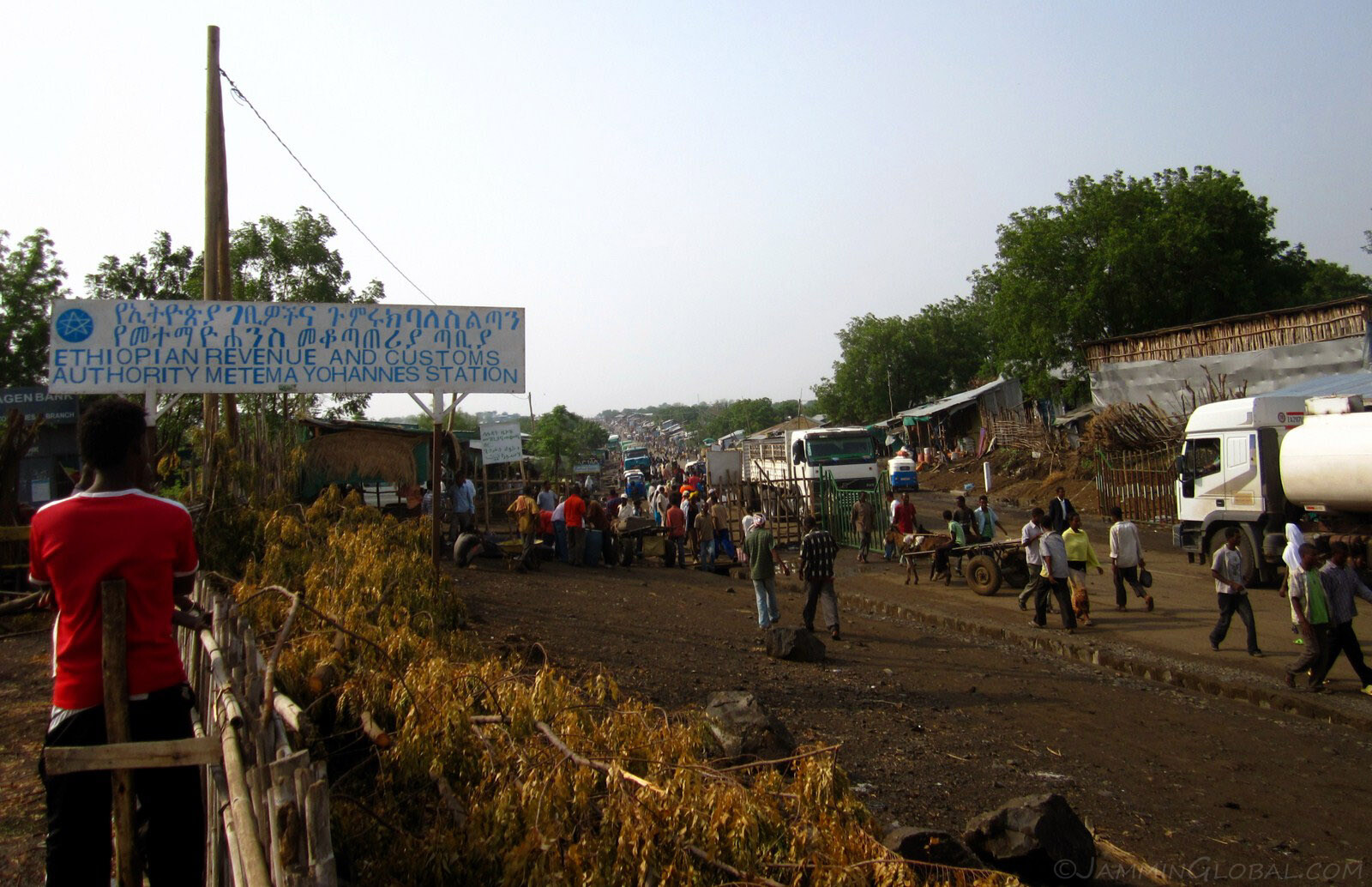
From the Ethiopian customs compound looking at the border town of Metema, just beyond those gates. I was currently in no-man's land as I had spent the night in the customs compound.
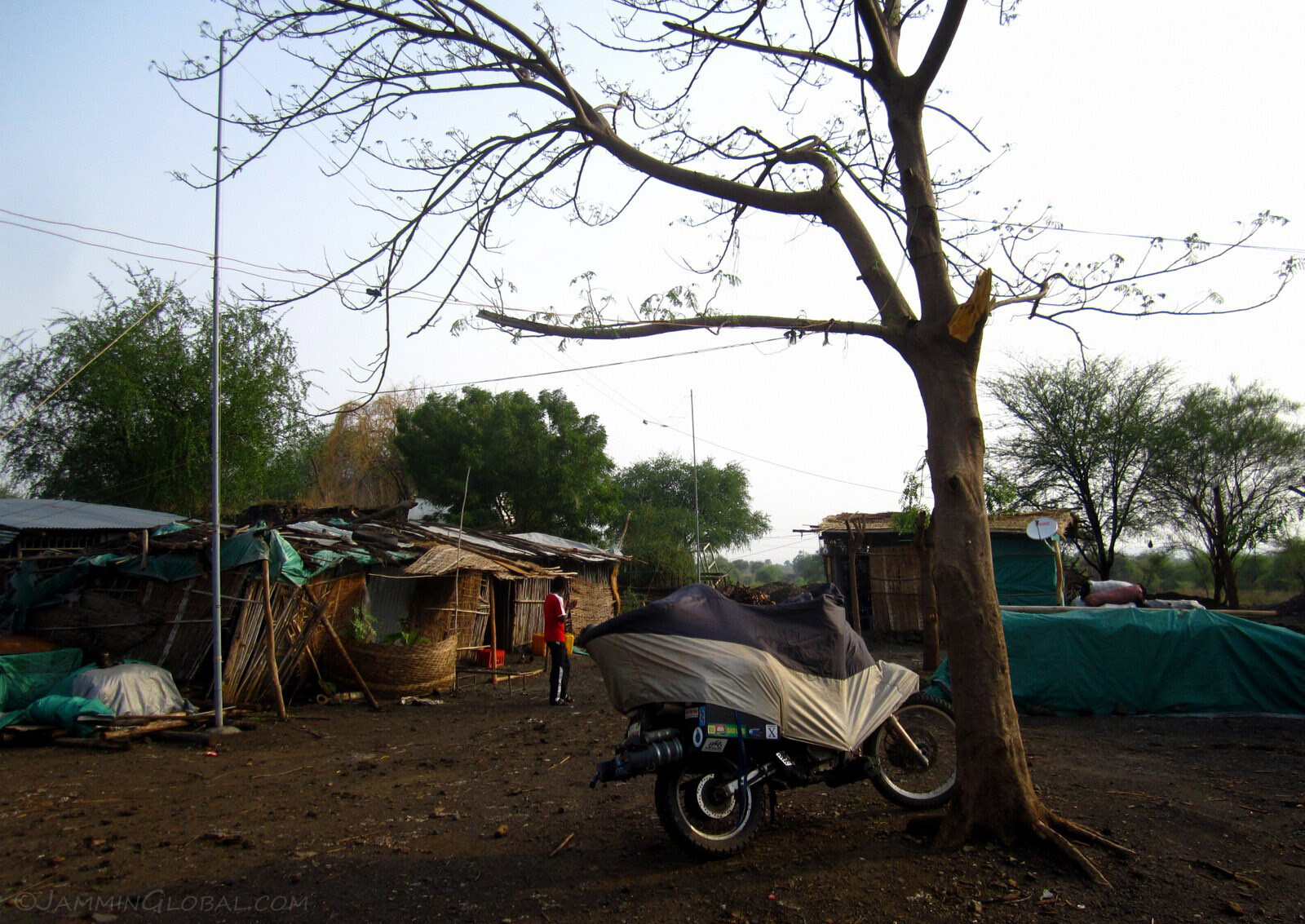
Due to my late arrival at the border, the previous evening, I managed to get myself through immigration but the customs office had closed and that meant sanDRina was checked out of Sudan but not checked into Ethiopia. The customs officers told me it was no problem and that I could camp there for the night and they would take care of stamping my carnet in the morning.
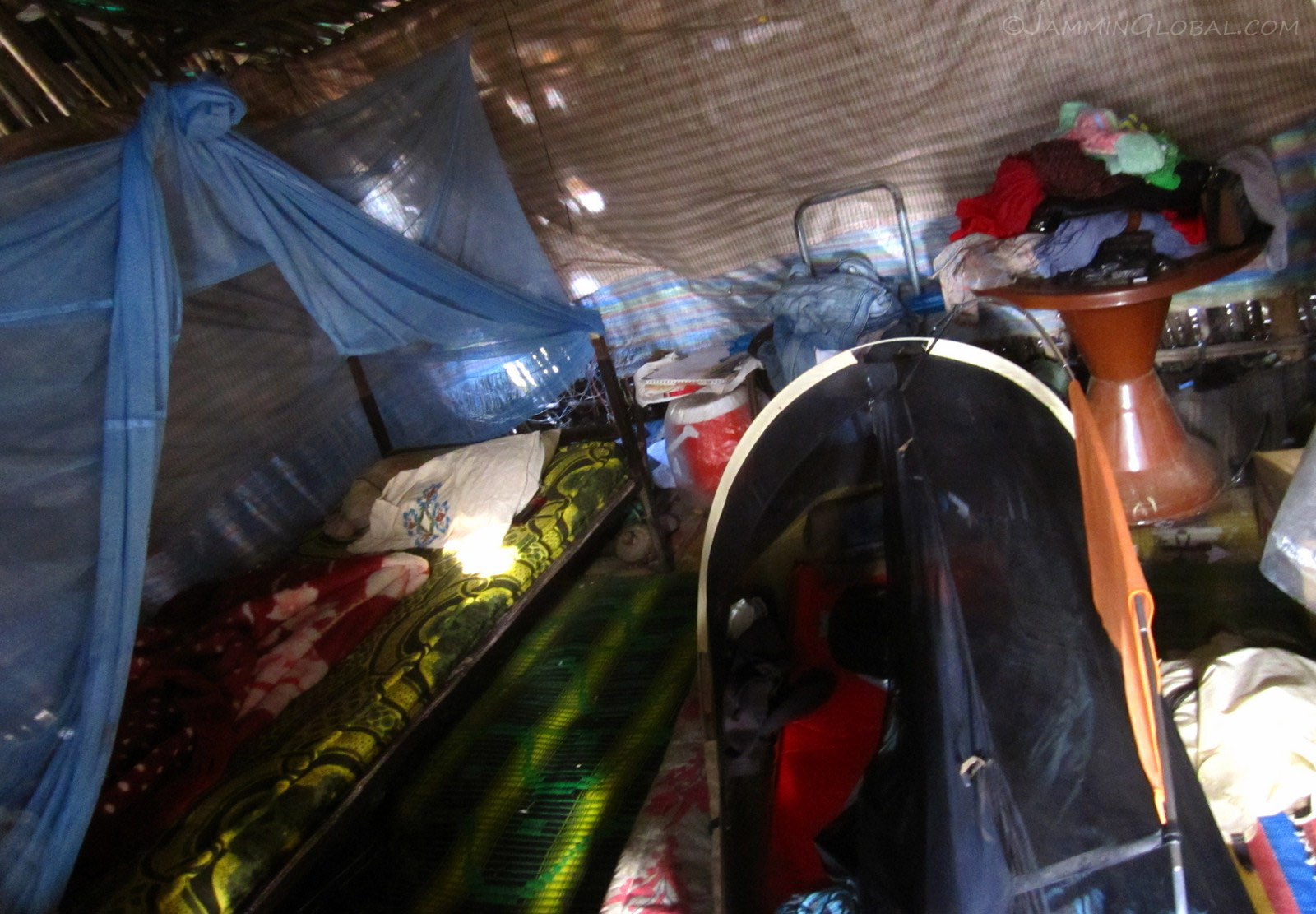
I had setup my tent next to sanDRina but a busted zip on my tent's rain-fly made me seek shelter from the nightly heavy rains in the hut of a customs officer. I had planned to just camp on the porch, but Officer Shimel invited me to bring my tent into his hut. How very nice of him. We chatted a bit and he told me he had just been posted here from the Djibouti border. Ethiopia has the unfortunate stance of being the most populous land-locked country in the world, so most everything is imported through the ports in Djibouti and Sudan. Officer Shimel told me that electronics and cars come through Djibouti and oil and gas comes through Sudan.

In the morning, before I could even brush my teeth or wash my face, I was told the customs office was open and quickly got my carnet stamped. With the documents all stashed safely, it was time to enjoy Ethiopia. Officer Shimel invited me for breakfast and I was so happy to smell spicy food cooking. The rich, red color comes from the spice mixture of Berbere, unique to Ethiopian and Eritrean cuisine.
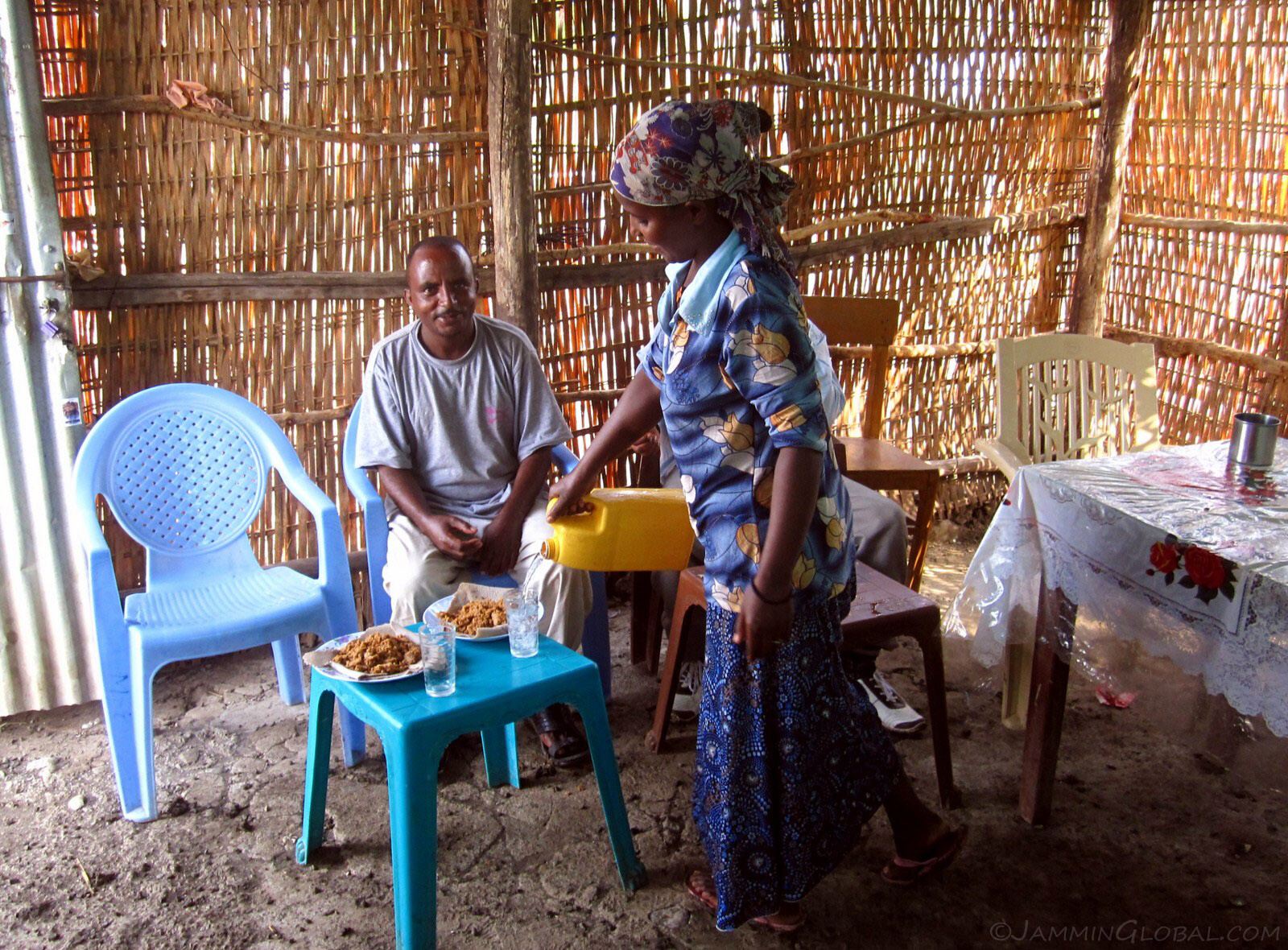
Officer Shimel in the customs dining room with a hot plate of fir-fir, which is chopped up injera mixed with the spicy berbere sauce that was cooking outside, served on top of injera. The staple carbohydrate in Ethiopian cuisine is the uniquely-tasting injera, which is a slightly sour, spongy, flat bread made with teff, a cereal that is native to the Ethiopian Highlands.
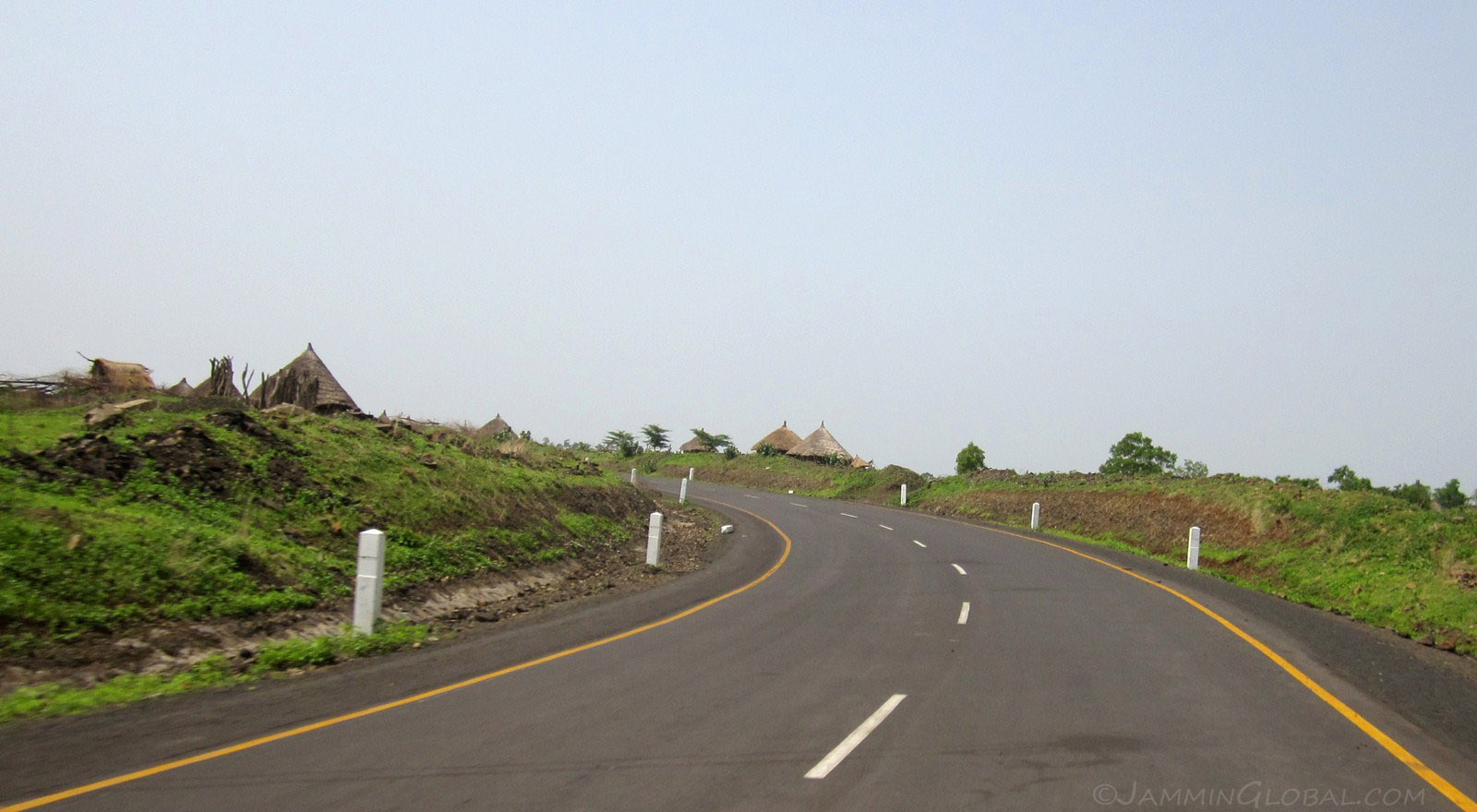
After a hearty and spicy breakfast, I rolled out of Metema and into the exciting mountainous landscape of Ethiopia that I heard so much about from passing travelers. After riding in the desert for the past six weeks, I welcomed the rise in altitude. It was about 760 m (2,500 ft) at the border and I would soon climb higher. Note the yellow line on the outside of the road - must be the same Chinese company that built the roads in Sudan.

My route through Ethiopia. I entered from Sudan, went north to Axum, then south through the whole country, exiting at Lake Turkana. Click on it to go to the interactive version in Google Maps.

Hello, donkey. I'm extremely weary of animals on the road or by the roadside. Most motorcyclists are, but the message was driven deep in our community after the tragic story of Ozymandis on ADVrider. I slow down, acknowledge the animal and proceed around its back, because it's not wise to cross in front of an animal, in case they decide to bolt straight into you.
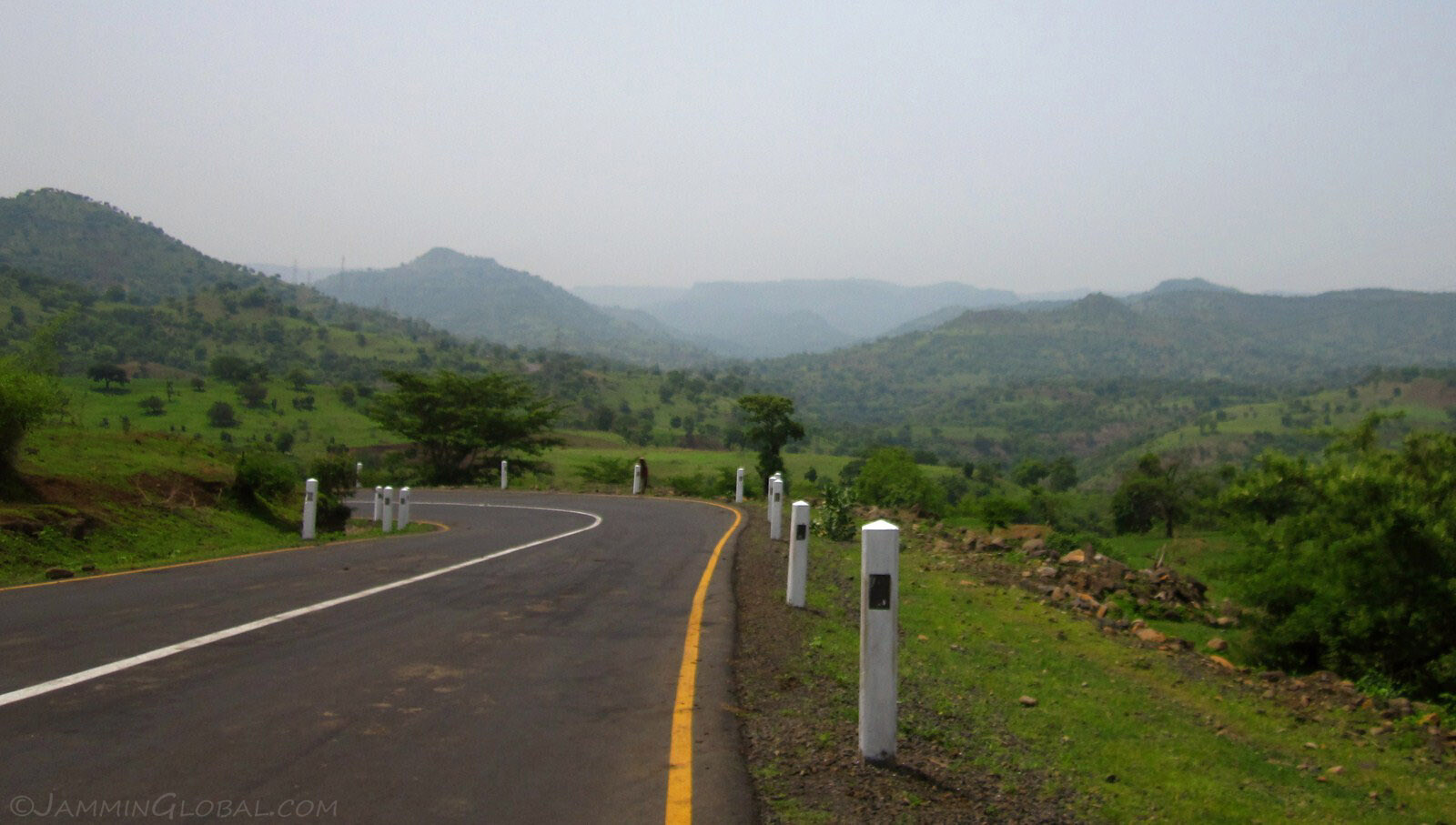
Ahh, mountains, greenery, twisting tarmac, come to me!
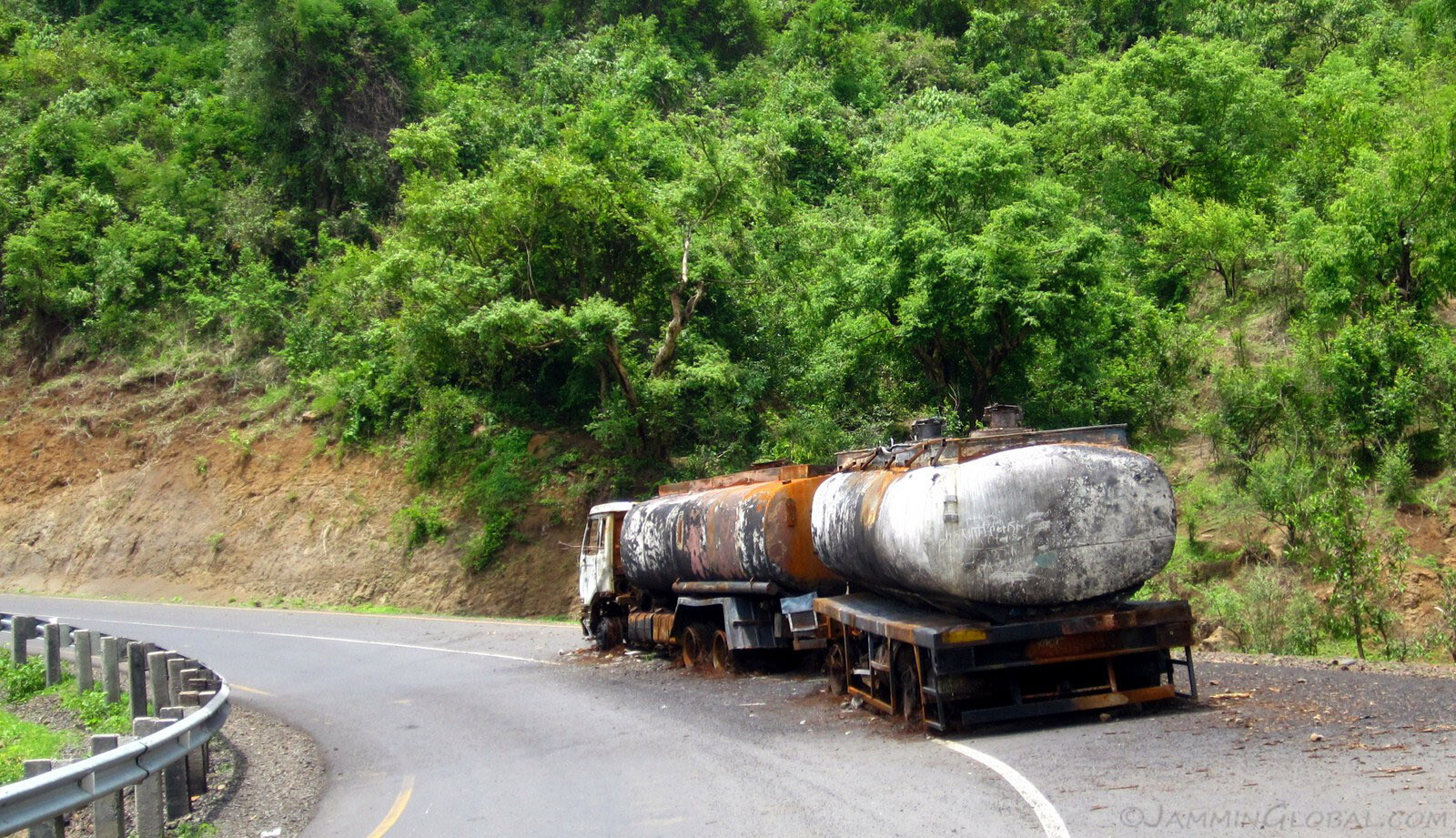
Passing an ominous sight: a burnt-out oil tanker. Interesting that it caught fire, but didn't explode. With the tires burnt away and the rims ground into the tarmac, it doesn't look like it'll be moved for a while.
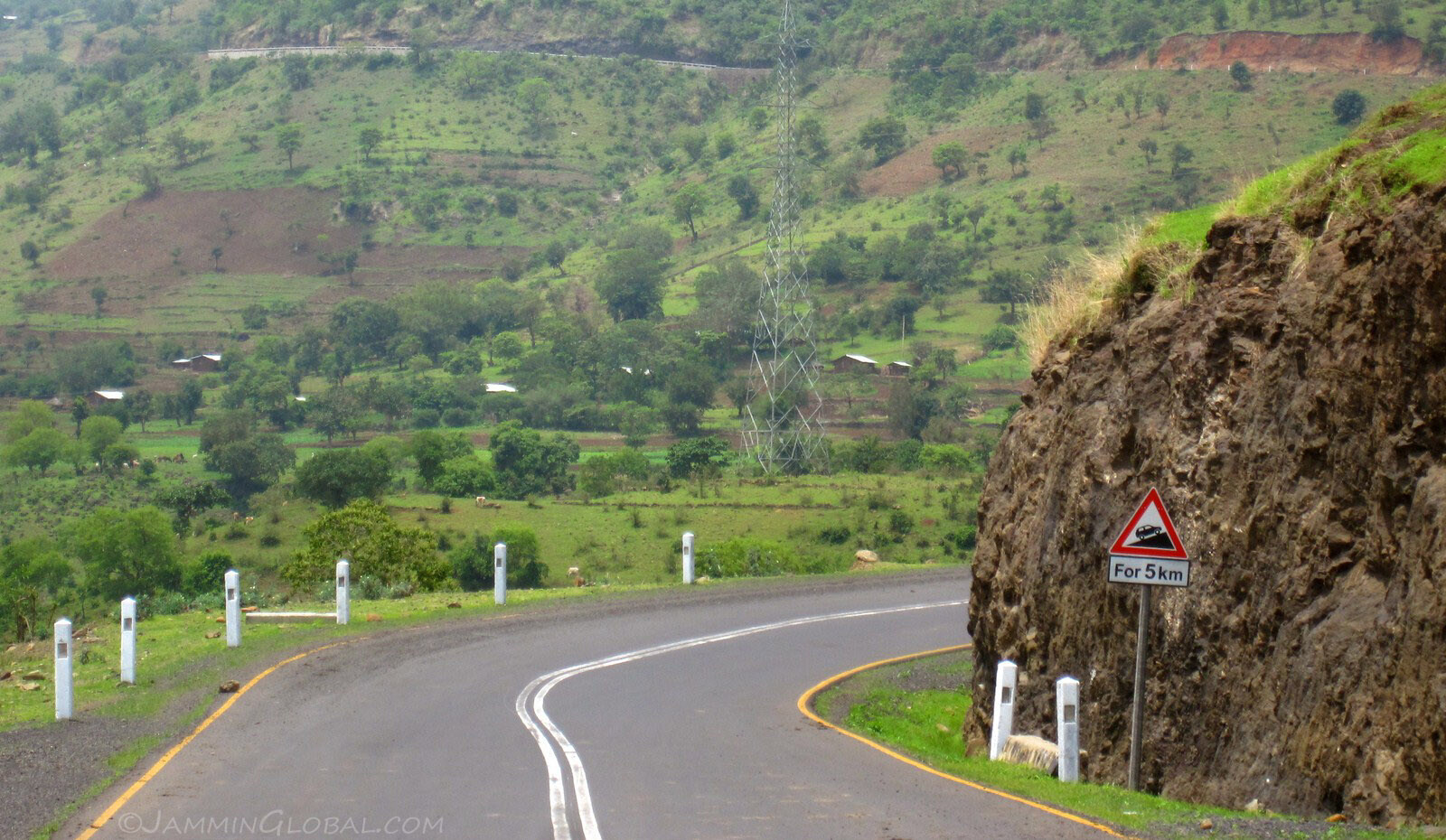
A welcome sign - inclines for the next 5 kms.
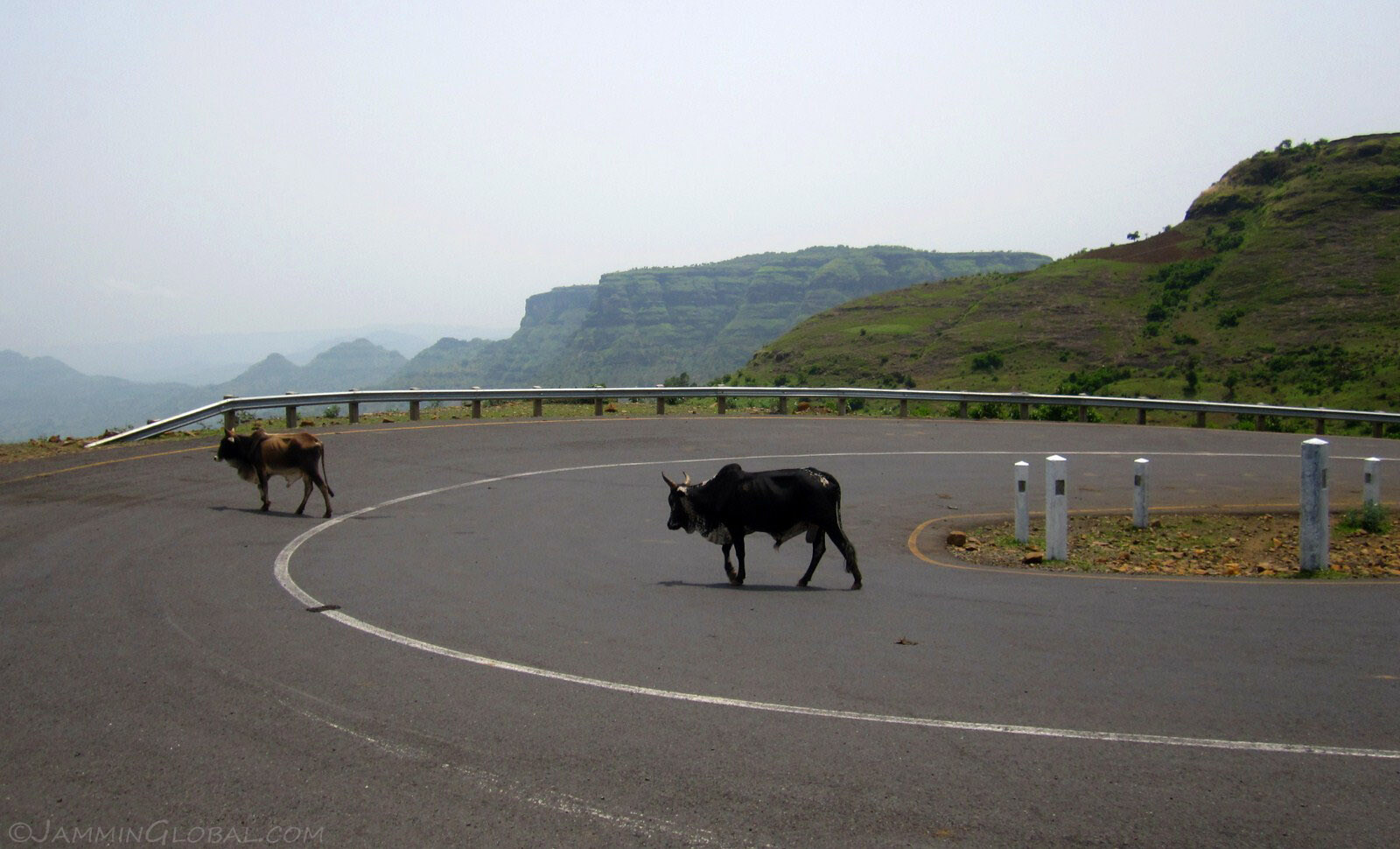
It was quickly apparent that Ethiopian roads were crowded with livestock and people. I couldn't commit to these beautiful corners because Mr. Moo might be crossing. This road is just under a year old and was paved to increase commercial links with Sudan, but this route has been used for ages by the locals to move their animals through the mountains.
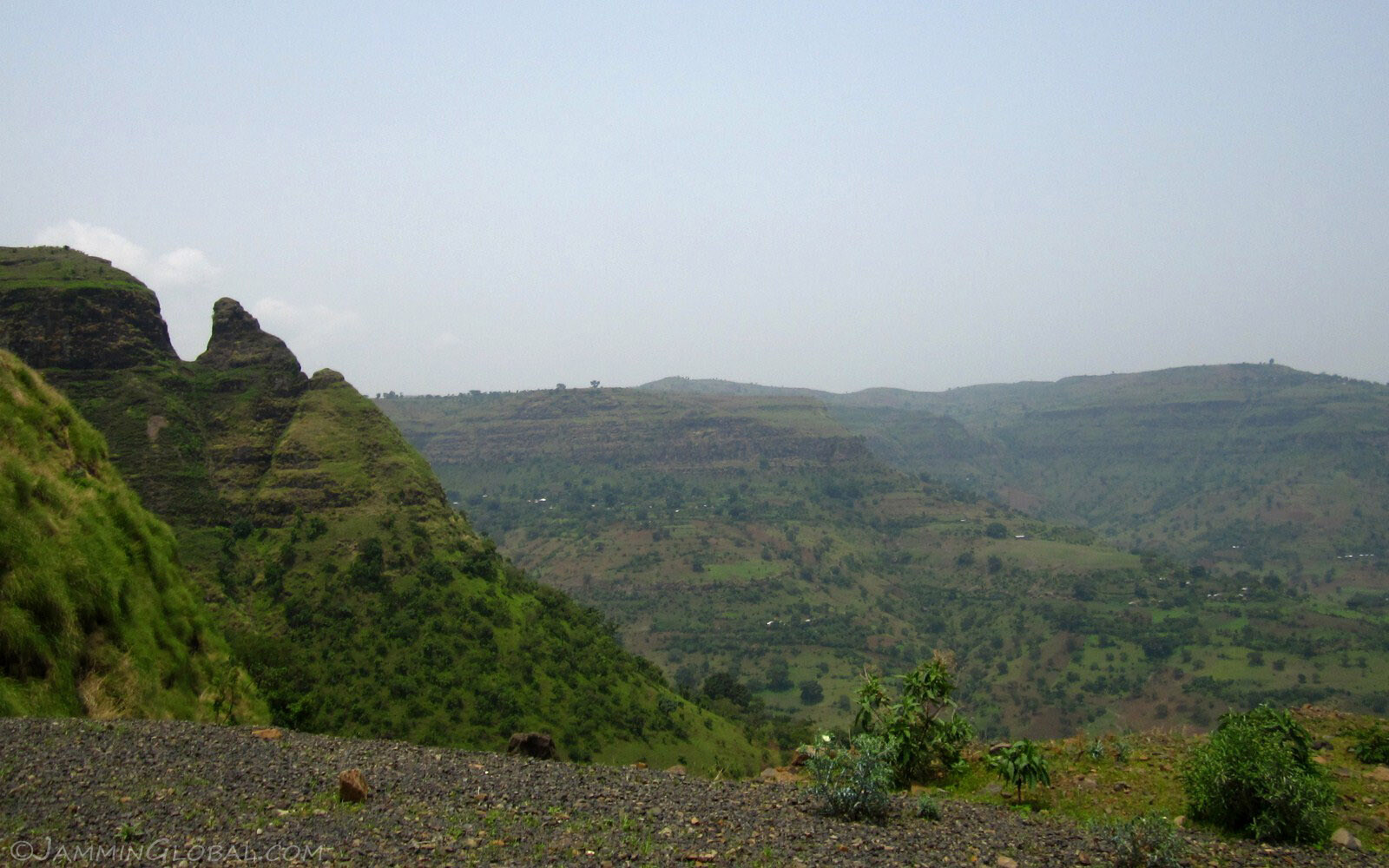
A taste of the Ethiopian Highlands. The 200 km (124 mi) stretch from Metema to the junction town of Gonder peaked at 2,265 m (7,430 ft) and I felt chilly for the first time since riding in Africa and welcomed the feeling.
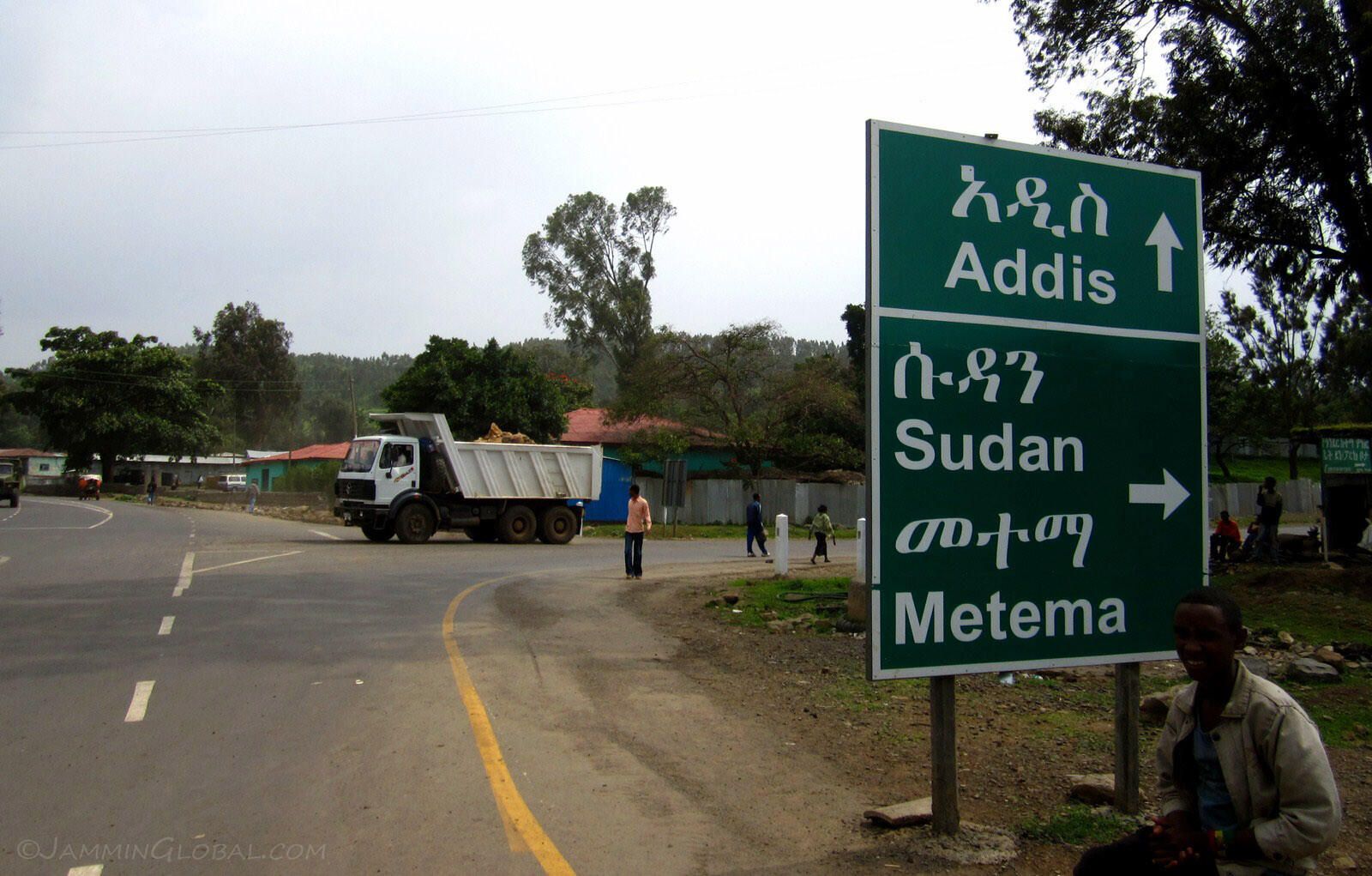
The road from Metema joins the northern loop around Ethiopia, that starts in Addis Ababa and rounds off at Axum. The town of Gonder is a few kilometers north of here, but I was heading south to the village of Gorgora on the shores of Lake Tana. The script on top of the English is Amharic, the official language of Ethiopia, which is a semitic language, like Arabic and Hebrew.

Happy to be back on dirt roads; on the way to Gorgora and looking forward to a break in the trip.
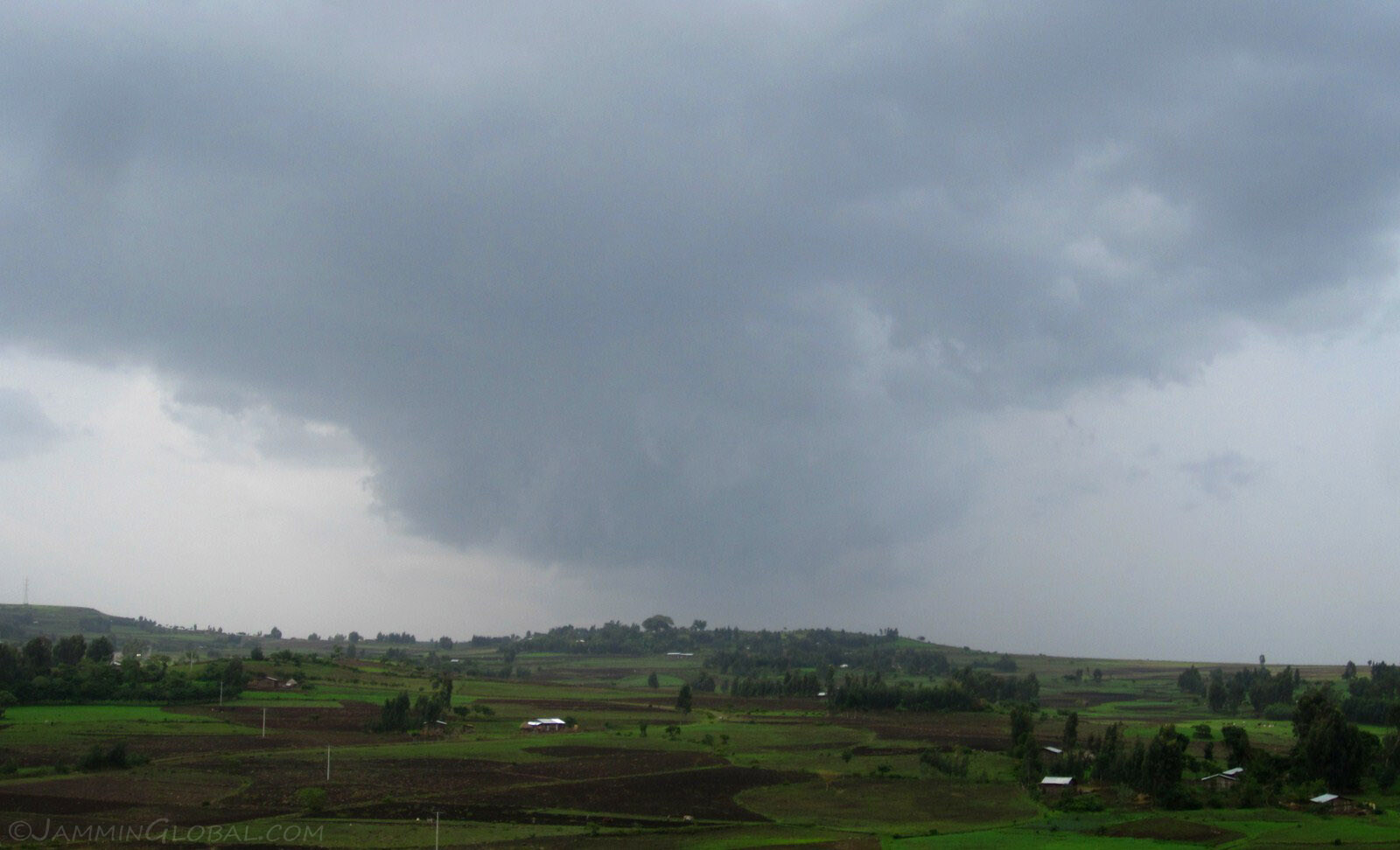
The rainy season had started in Ethiopia and that rain cell was in the direction I was headed. While I wasn't looking forward to mud-riding, just yet, I'm sure all the farmers were happy for their rain-fed crops. There is an abdundance of fertile land in Ethiopia and it is a sad reality that so much of the population still suffers from food insecurity.
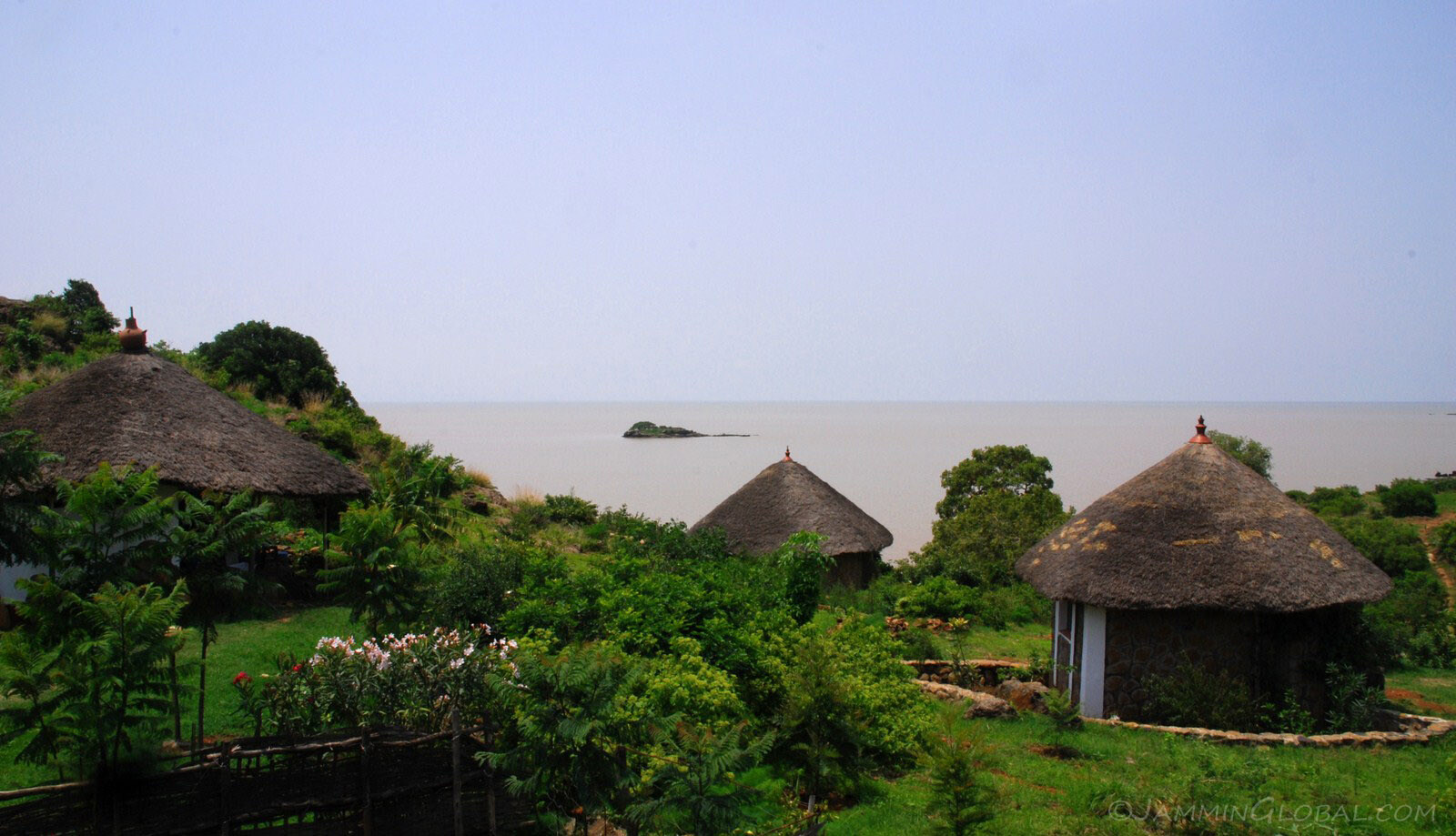
After a 50 km (31 mi) ride from the highway, I arrived on the shores of Lake Tana and the overland site of Tim and Kim Village, near the village of Gorgora. Tim and Kim are from Holland and they've slowly been building this collection of campsites and cottages with the aim of leaving a positive impact on the inhabitants of nearby Gorgora.
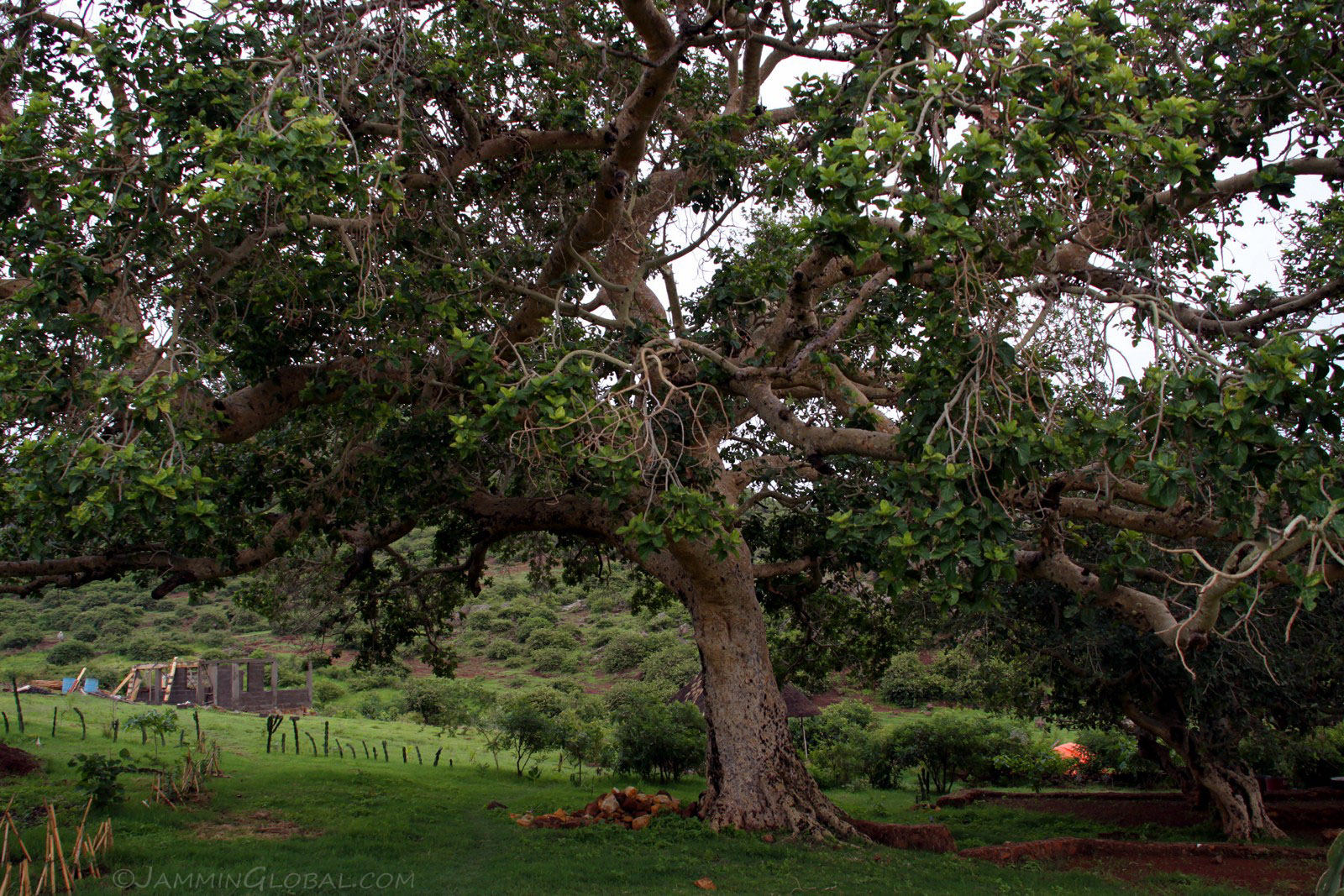
They backpacked around India and Africa and after being moved by their experiences, they decided to give back by training rural Ethiopians to get a foothold in the growing tourism industry. They acquired this gorgeous piece of land on the northern shores of Lake Tana and setup a foundation in The Netherlands to raise funds to help with the construction of their eco-village. Any profits from guests are used for development projects in Gorgora.
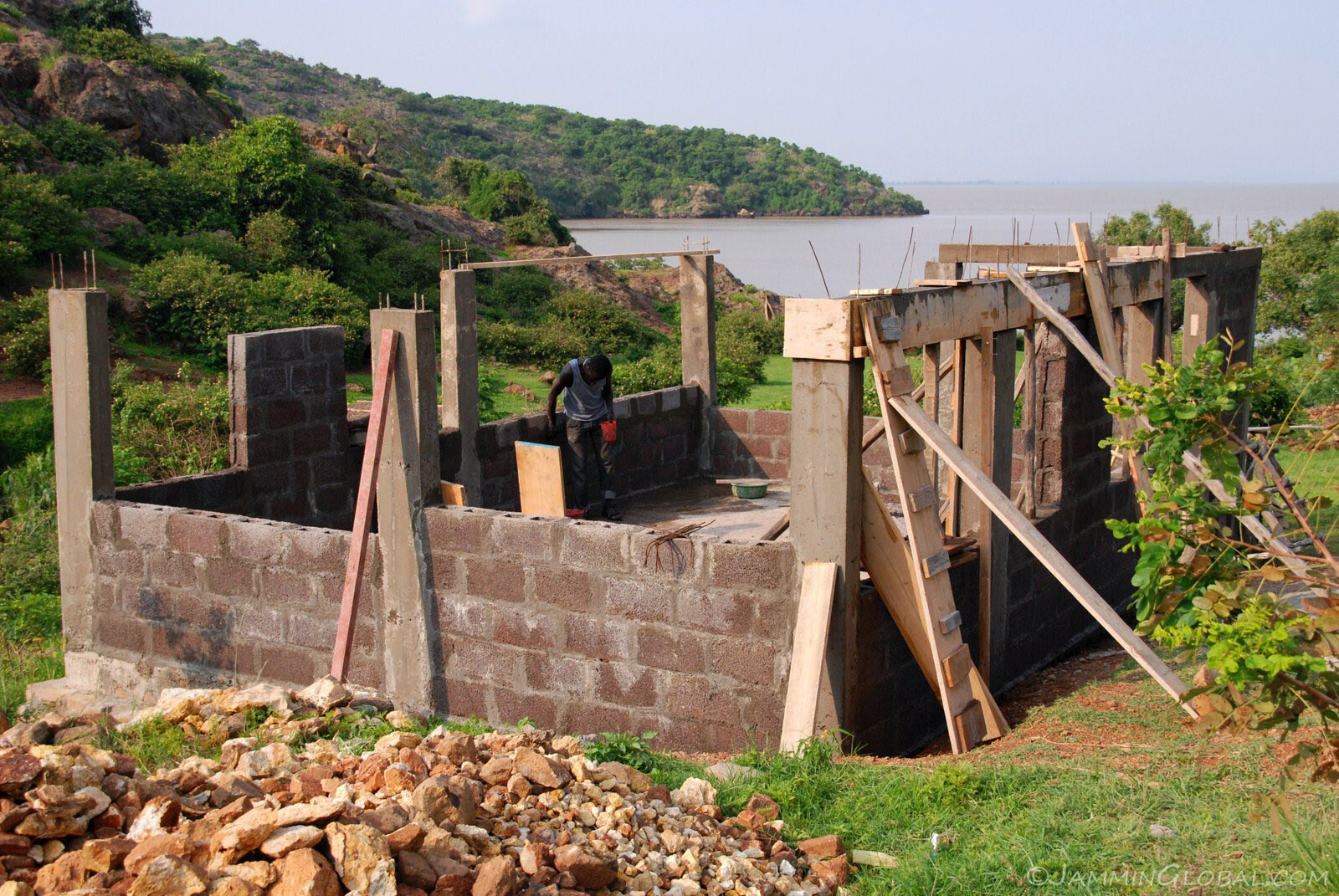
Tim and Kim started here in 2007 and most of the construction has been by their own hands and a few dedicated local hires. Construction was still on-going and I asked them if I could stay for an extended period and help-out in exchange for accommodation and they agreed.
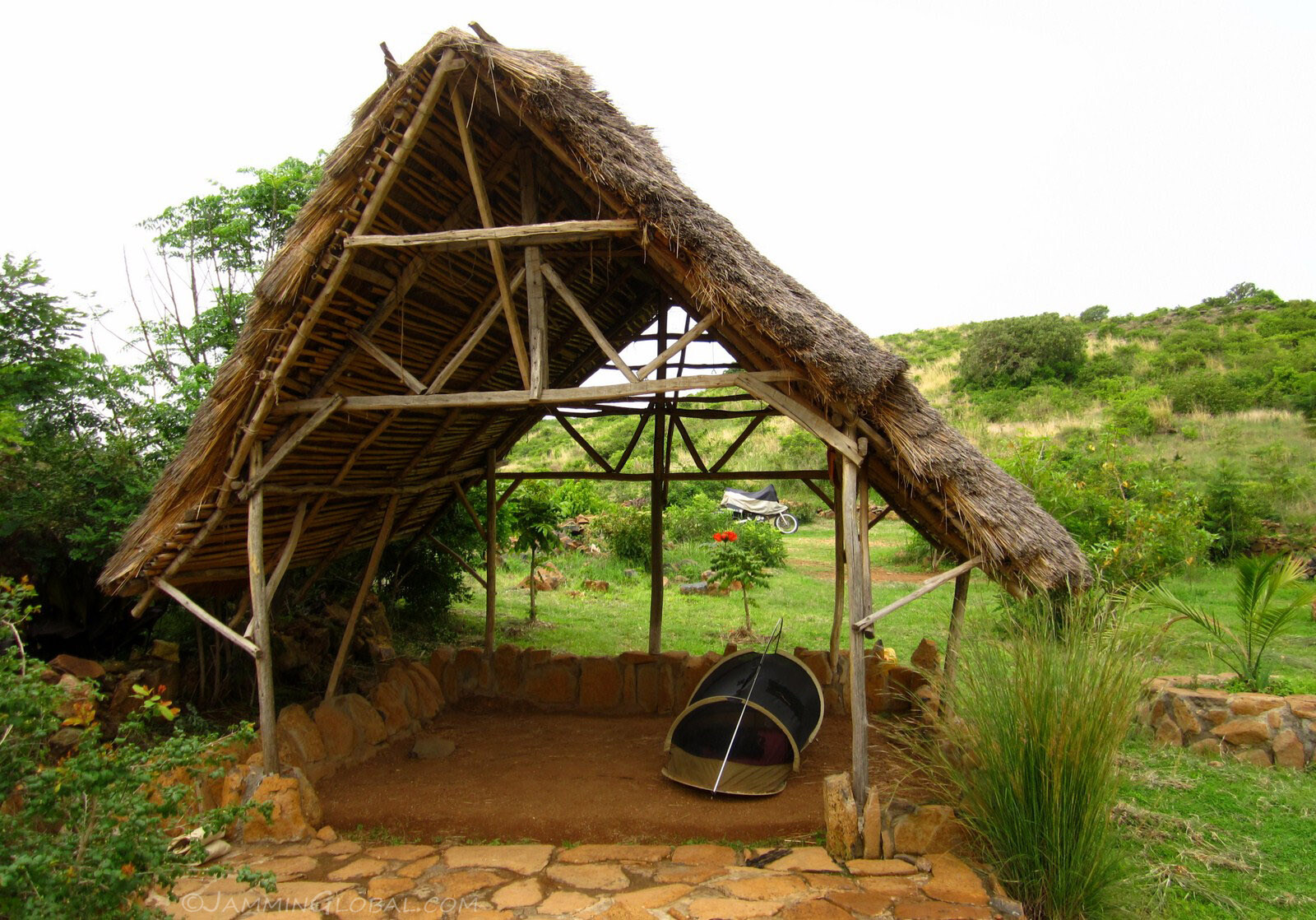
They let me camp under this shelter, which became my home for the next two weeks and I was happy to find a beautiful, tranquil place to rest for a while, after the heat of the desert.

Tim and his right-hand man, Yanou from Gorgora, taking a break while setting up the supports for a beam.

Yanou was a hard worker and Tim was grooming him to take over when all the construction would be done. He worked on road construction projects for the Chinese and although the pay was higher, he said the quality of life and work wasn't worth being away from home for and thus returned to Gorgora and was now happy to have a position of responsibility with future growth in the cards.
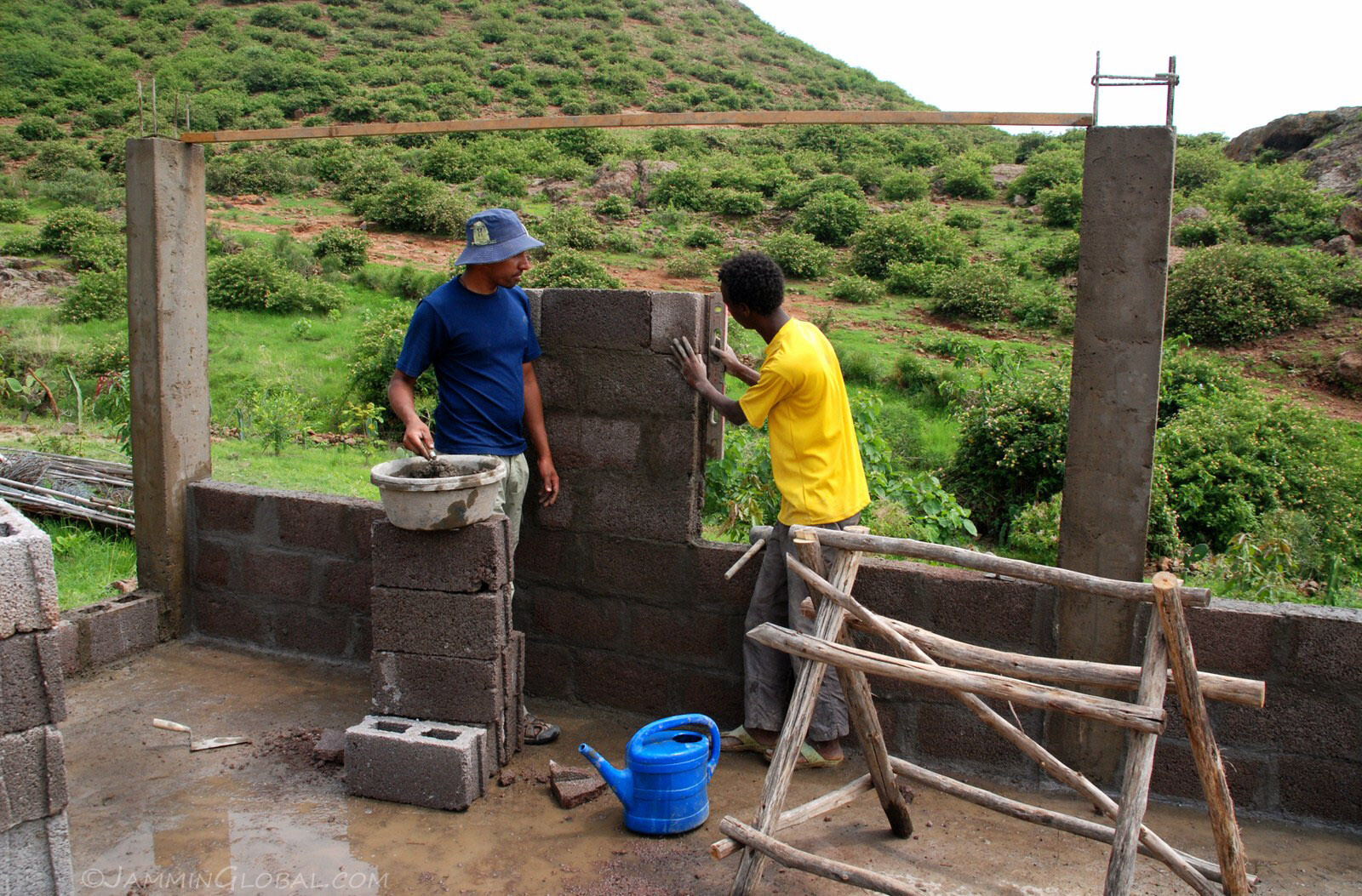
I got down and dirty with the cement and am working with Mariea (Maa-ri-yay) here to build up a wall between the windows. Tim was quickly impressed with my efficient work ethic and made me foreman-in-charge when he was attending to other tasks. And I guess with me having an engineering background, he could easily trust me to make wise decisions on the site. Yanou and Mariea worked well on their own, but most of the other local hires (daily laborers) needed supervision and motivation to keep going. I enjoyed these two weeks of hard work and got a good insight into the mindset of rural Ethiopians and an expat Dutch couple.
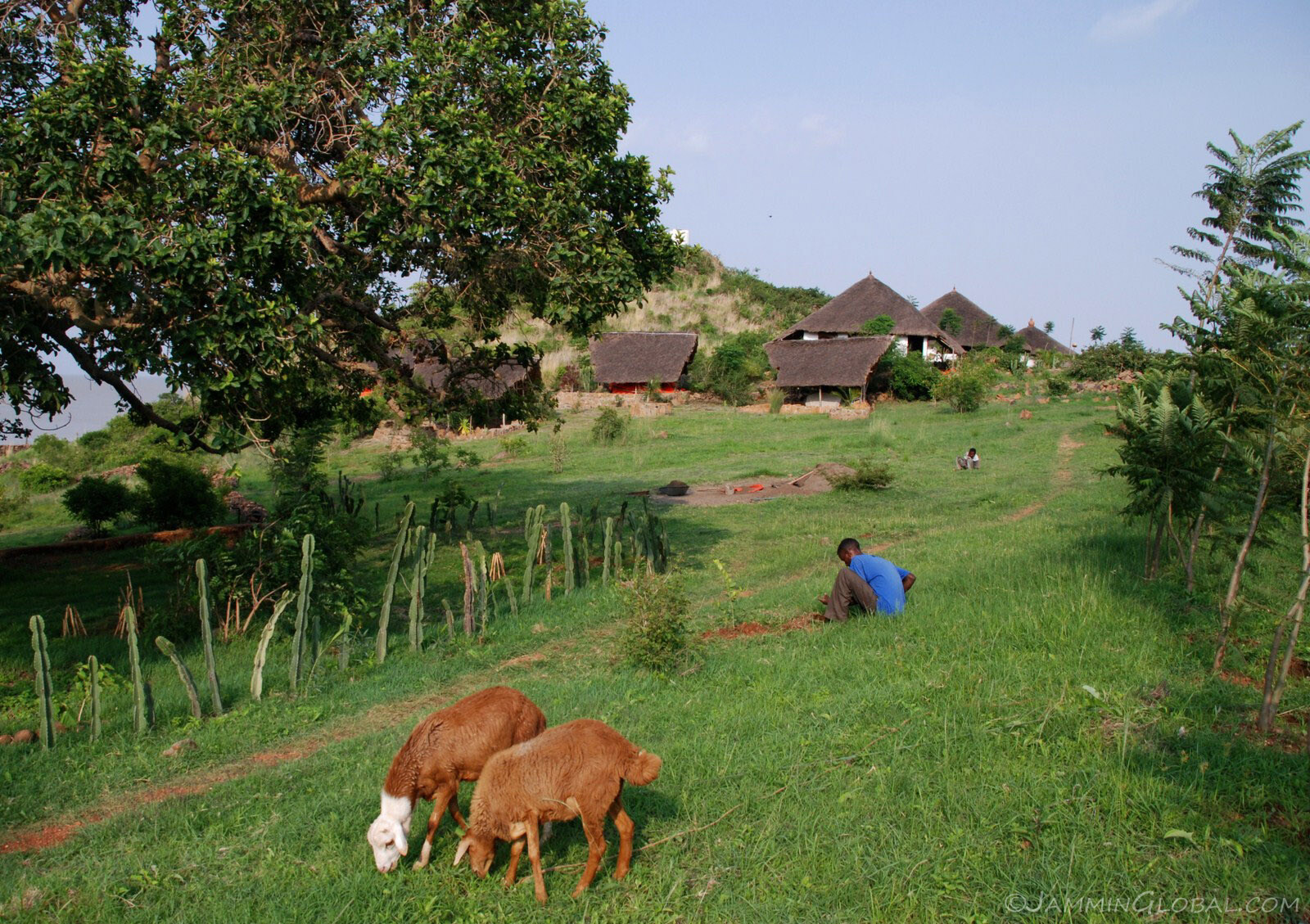
Life was good at Tim and Kim's. Work started at 7:30 every morning, with a break for some Dutch pancakes after an hour. A few hours of labor in and then it was time for our mid-day skinny dip in Lake Tana. The evenings and mornings were cold here at 1,830 m (6,000 ft), so a cold shower or dunk in the lake at the hottest time of day was wise. And why skinny dip? Well, there was no time to change into swim trunks, so simply just take it off, jump in the lake, soap, rinse, dry, put clothes back on and head for a slow lunch. Every few days or when other guests would arrive, a goat or sheep would be slaughtered and Kim would prepare a delicious meal.
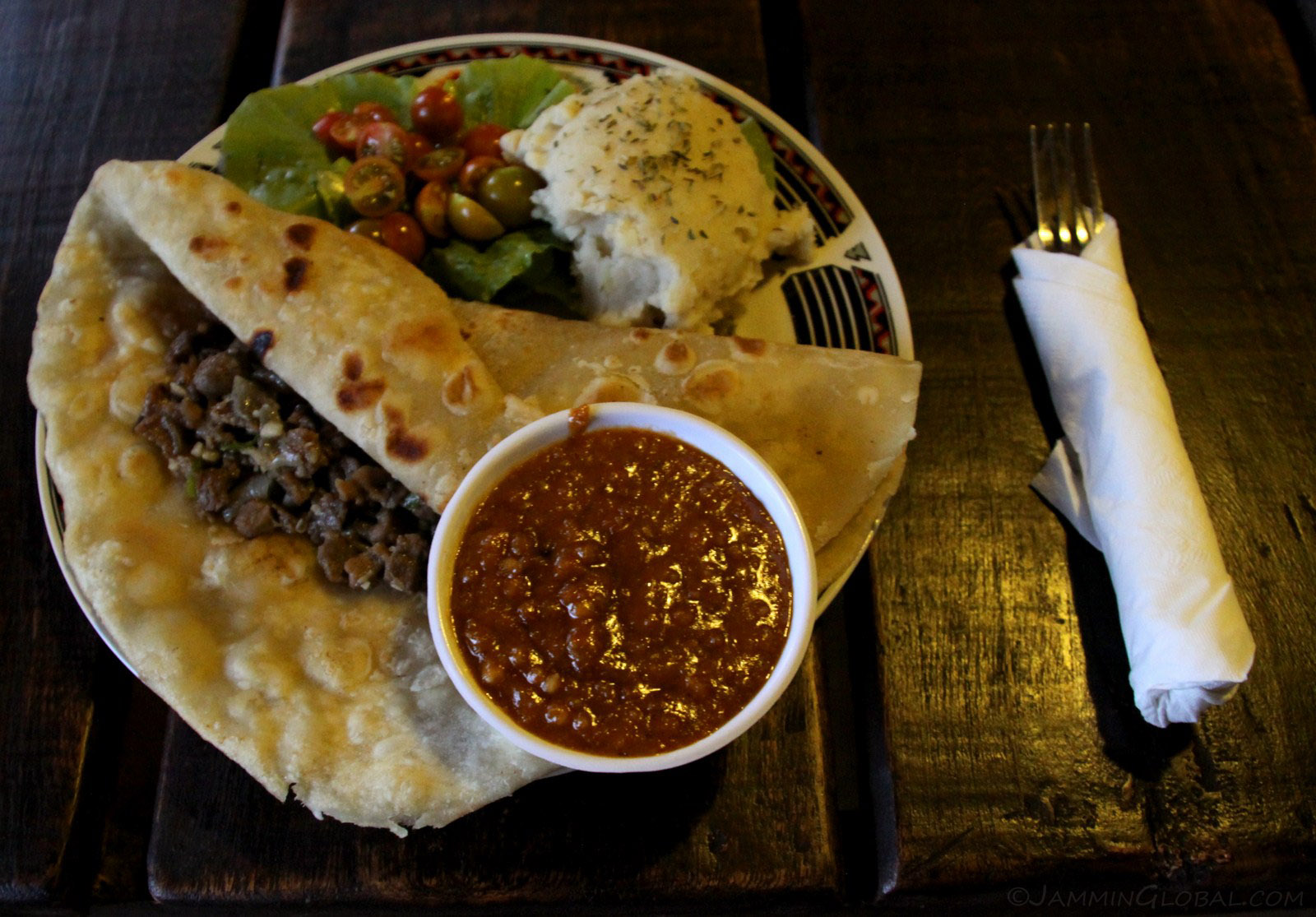
One of Kim's scrumptious meals of mutton fry with chapatti, beans, mashed potatoes and salad. I ate well during these two weeks.
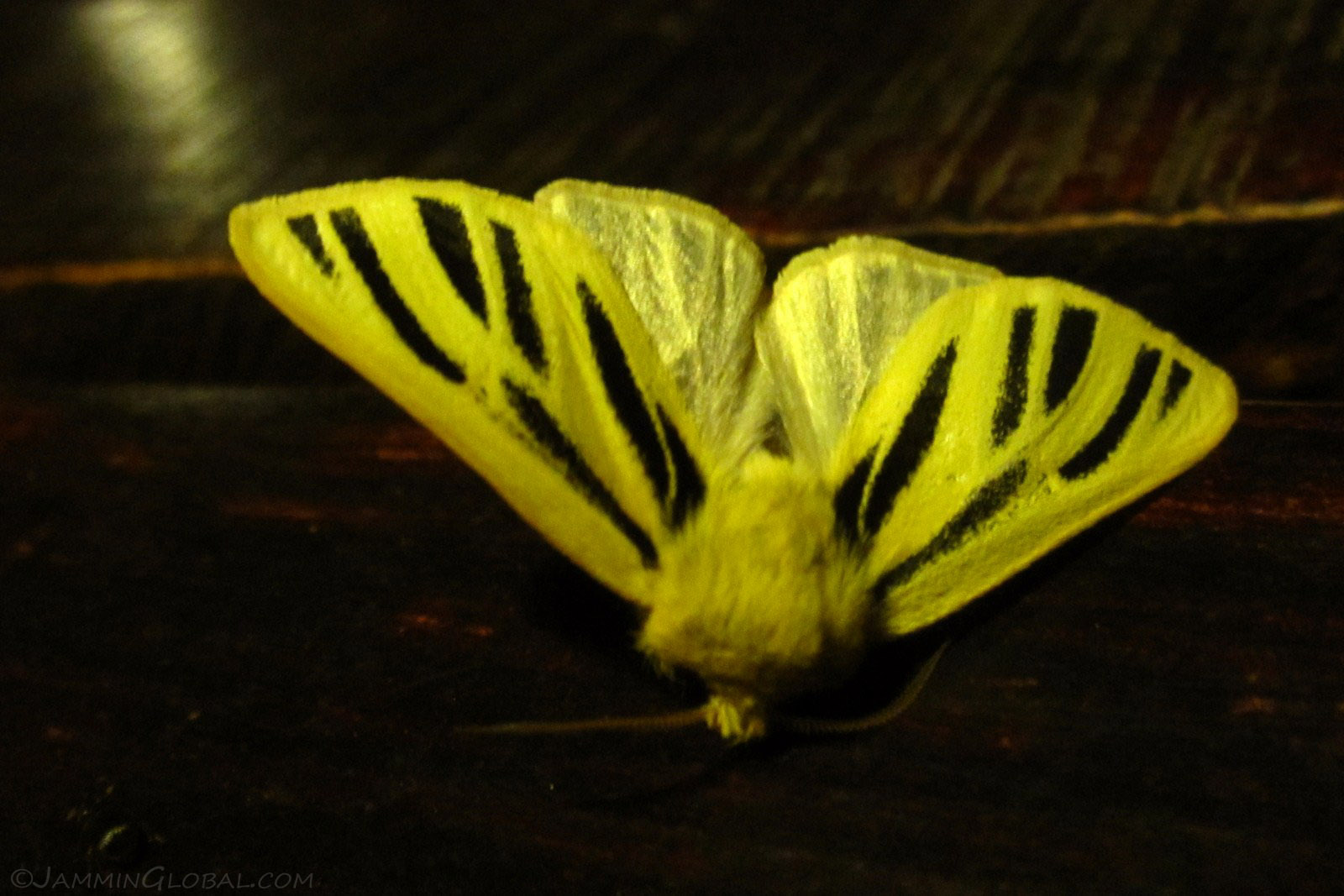
It would rain almost without fail every evening and with the rains came lots of insects, like this yellow butterfly.
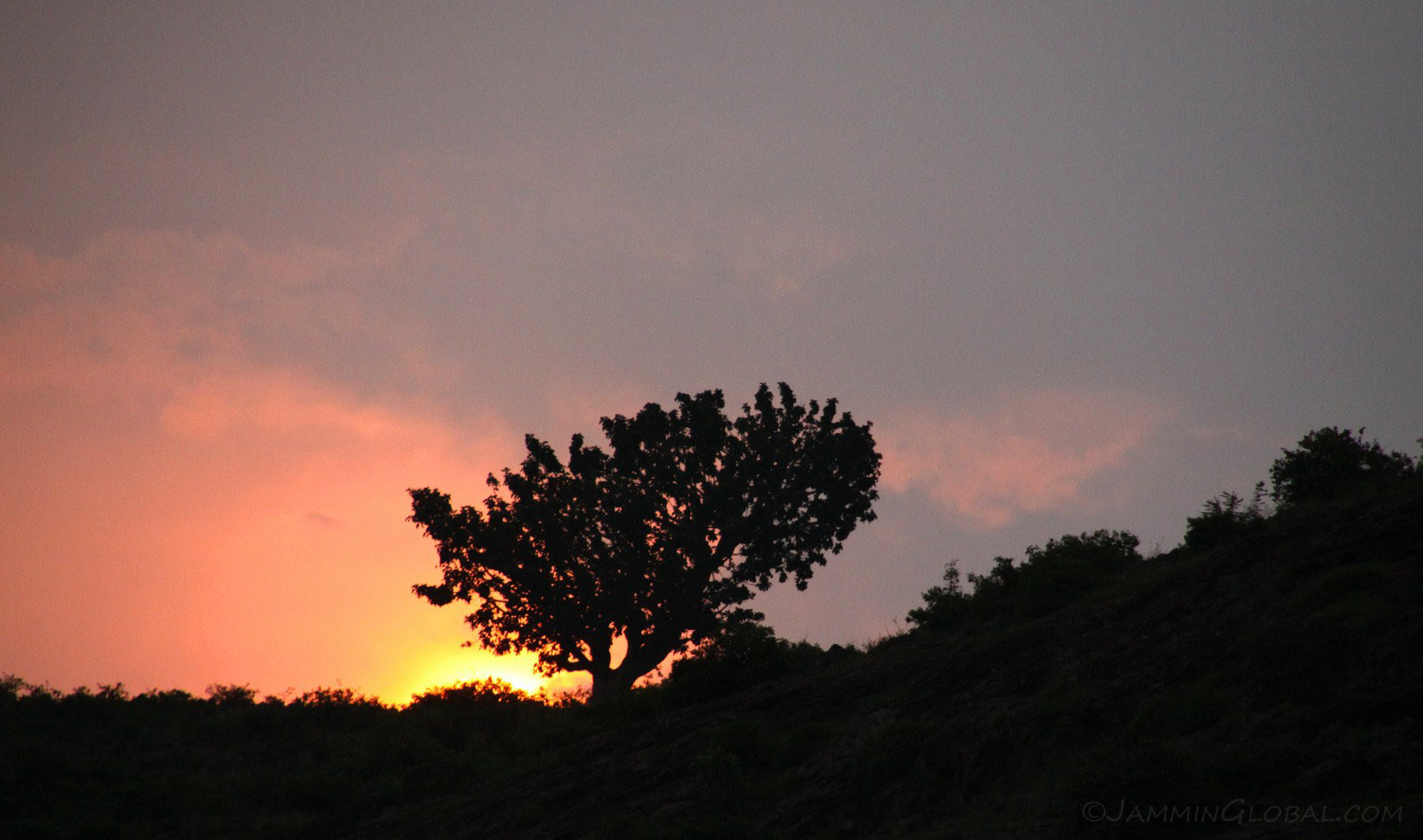
Enjoying beautiful sunsets from Tim and Kim Village. Some days that tree resembled a burning bush.
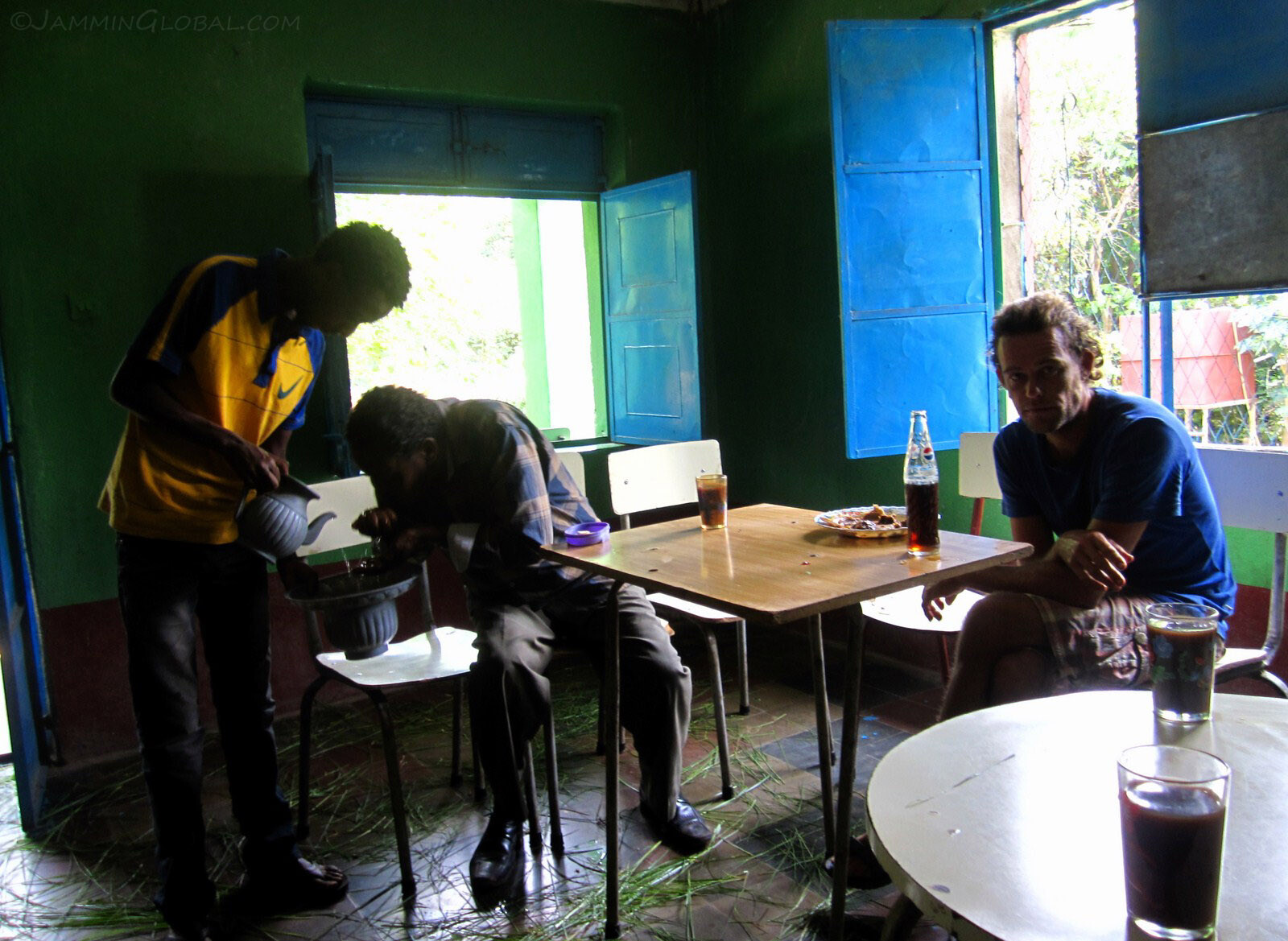
It was Mariea's birthday on the 26th and he invited us for a celebration in the village. Washing hands at the table and then starting off with some local brew, which tasted like chicha in Peru.
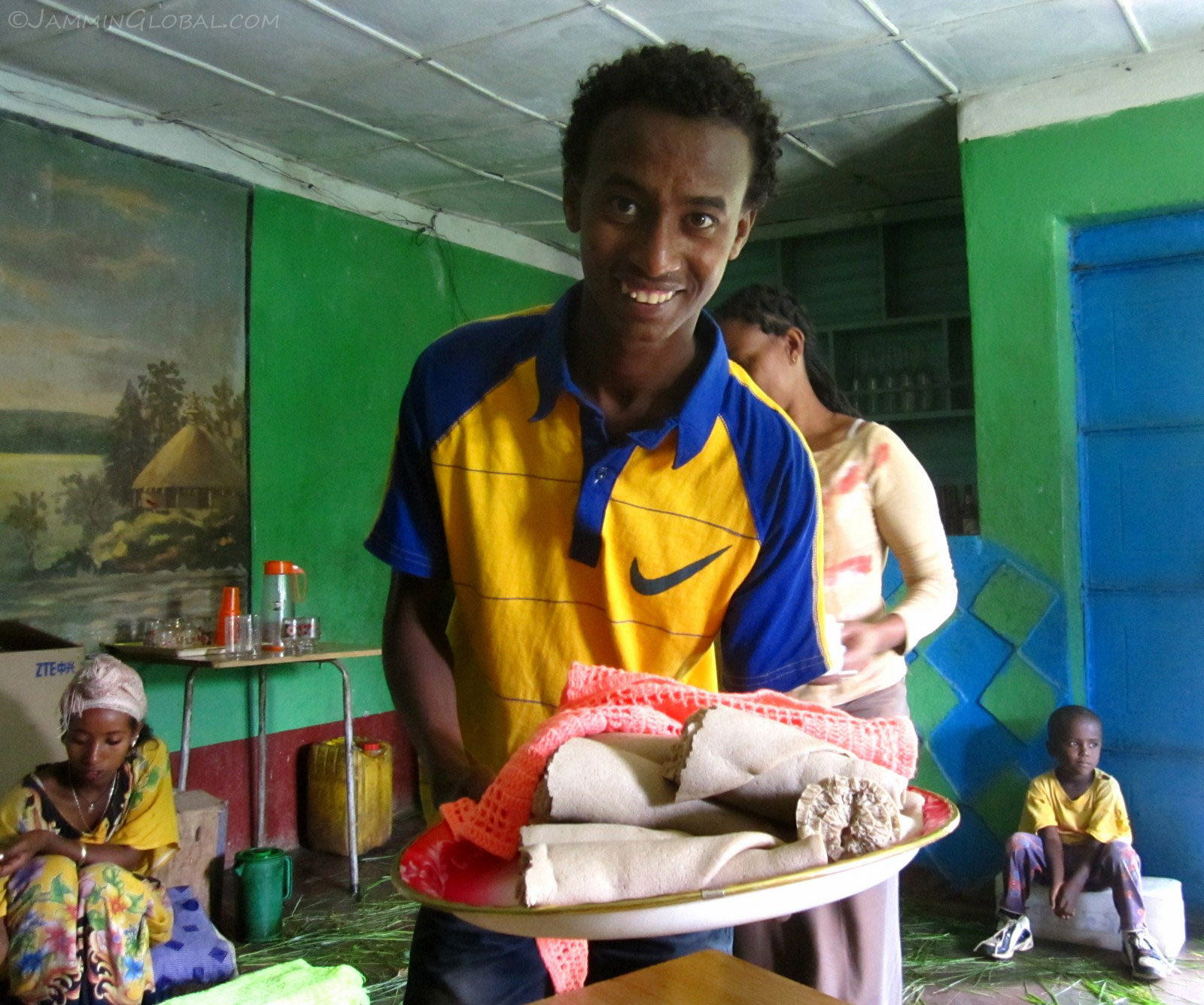
Mariea serving up hot injera. He had just turned 19 and being the sharp kid that he is, I think he has a bright future.

Injera served with a wat (stew) of boiled eggs. This food closely resembles my home food from South India, namely of dosa with egg curry, but it tastes so different.
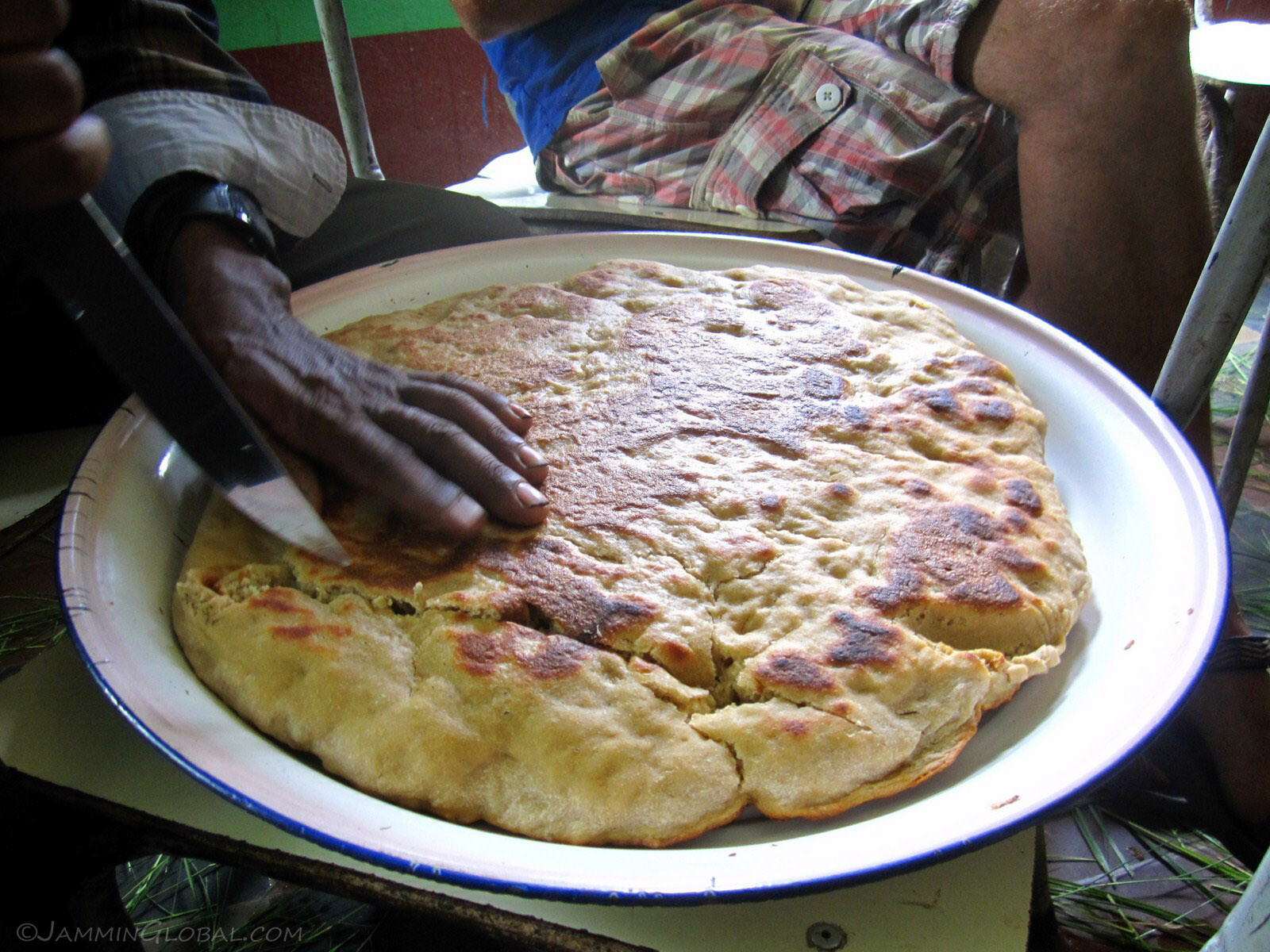
After the main meal, a large ceremonial bread was cut and passed around.

The roasting of coffee beans for the traditional coffee ceremony. At the end of the meal, fresh coffee berries are roasted and inhaling the smoke is a sign of bringing goodwill into your life.
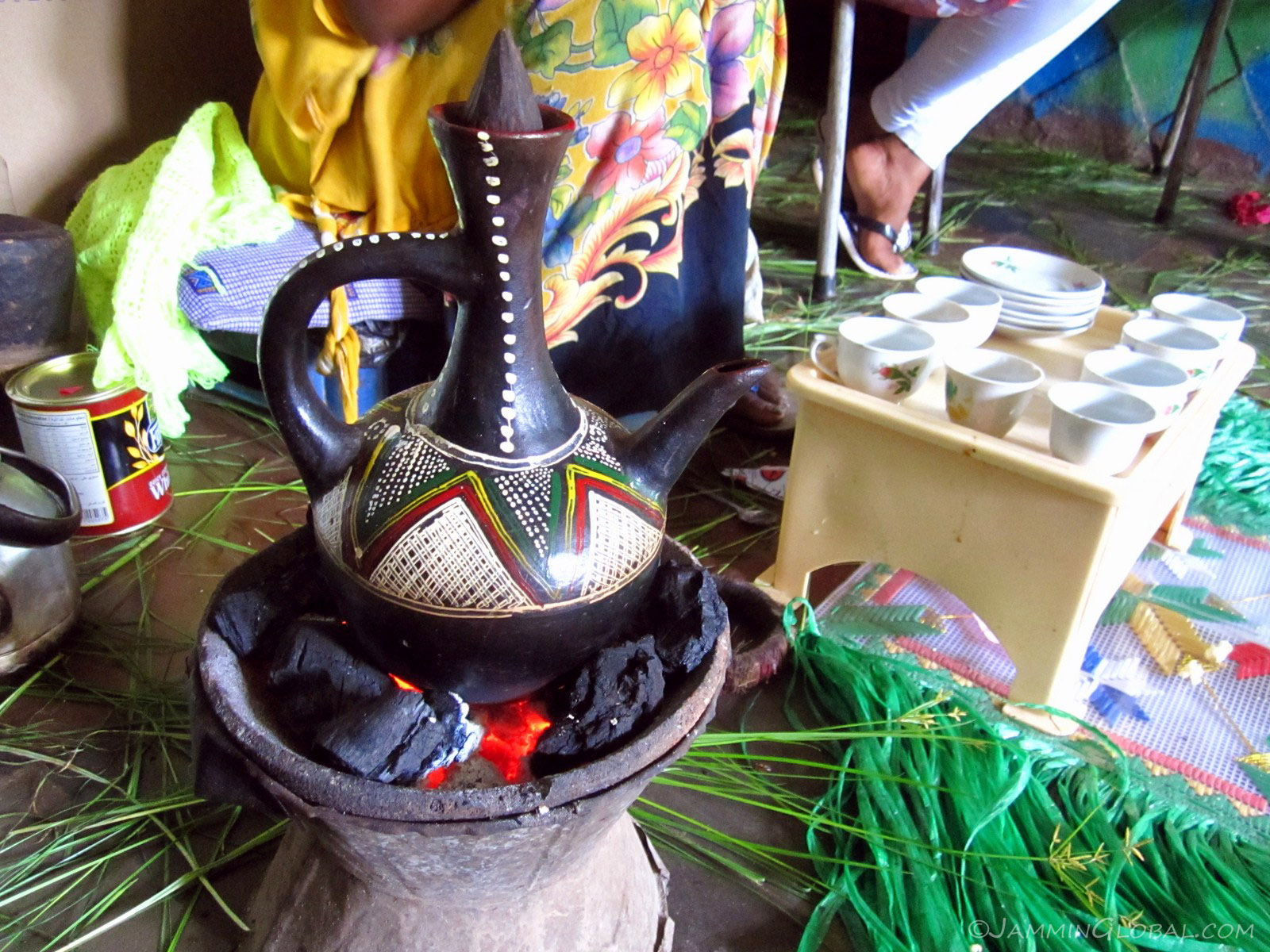
The roasted beans are then boiled with water in this beautiful pot to produce the black elixir. Note the freshly-cut grass strewn all over the floor, signifying abundance.
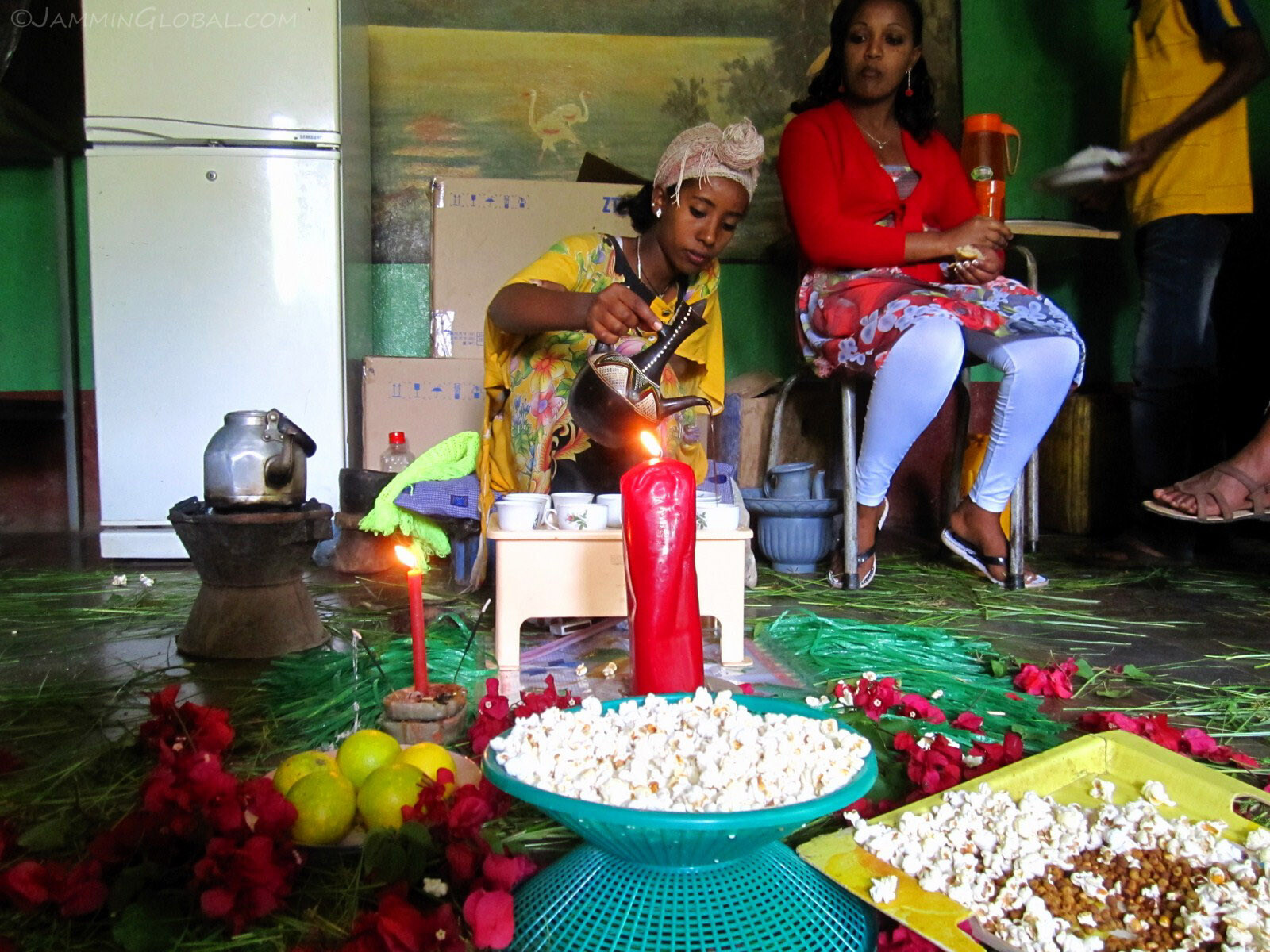
The Coffee Ceremony Lady pouring the first of three rounds of coffee, with each round slightly weaker than the previous one. There is a setup that resembles an altar around the coffee ceremony with offerings of fruit and popcorn.
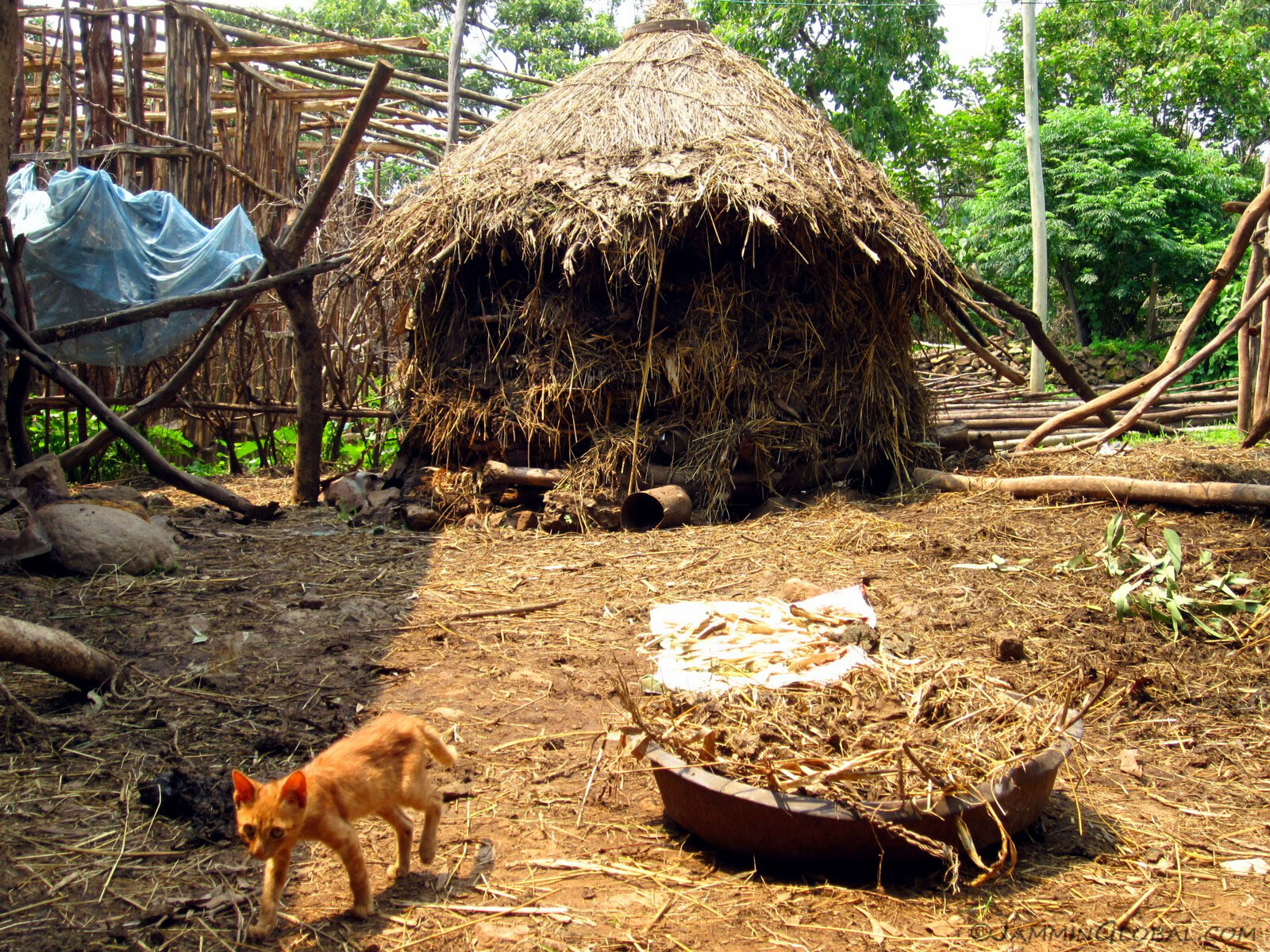
After the celebration, Tim took me for a photo walk around the village of Gorgora.

Since he was known and respected by the villagers, I was free to take photos of everything. Here, a woman is preparing injera with a large metal lid as a cover.
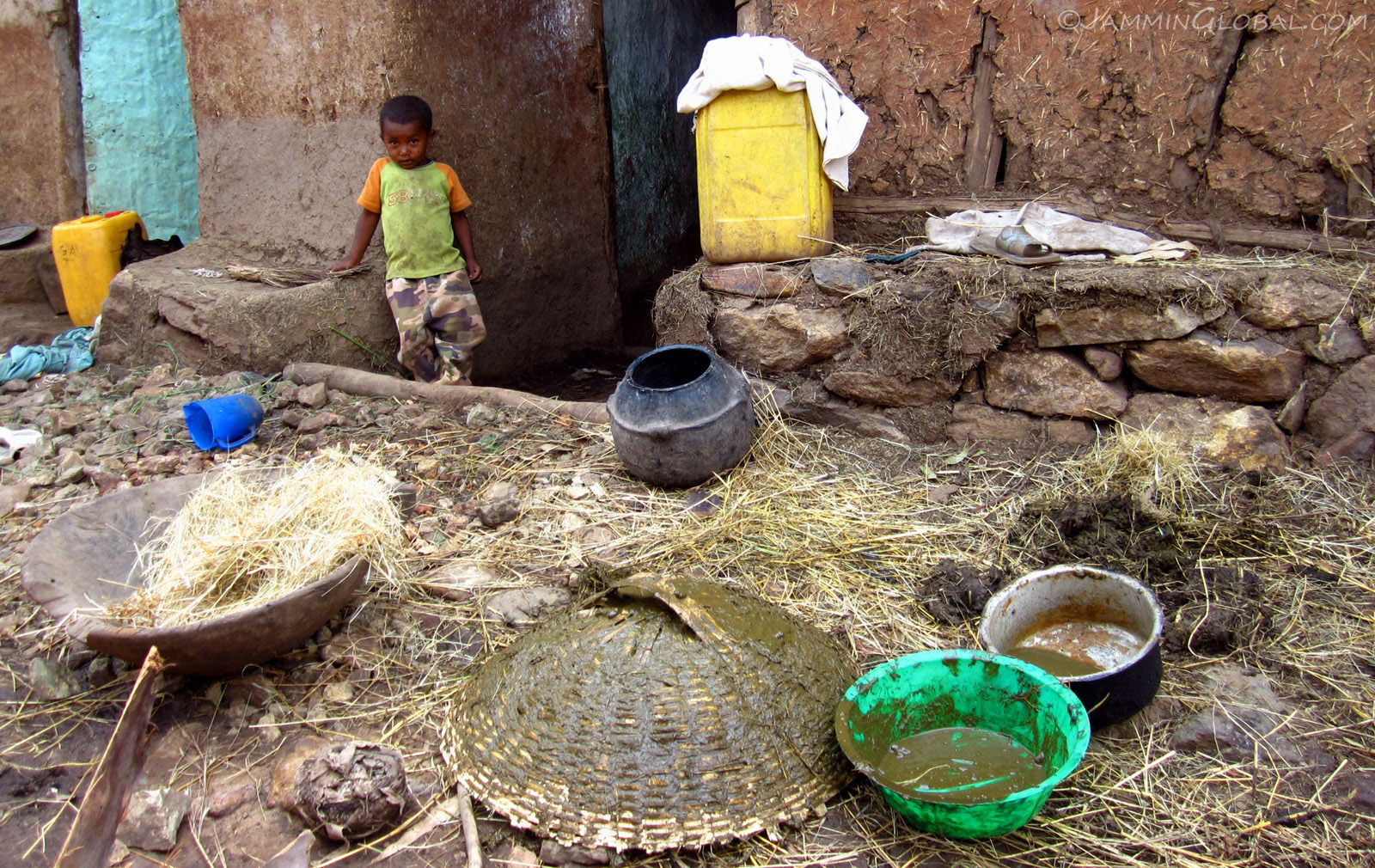
A cover for injera made with reeds from the lake and getting a sealing of cow dung. Once it dries, there's no smell and it works as a great insulator.
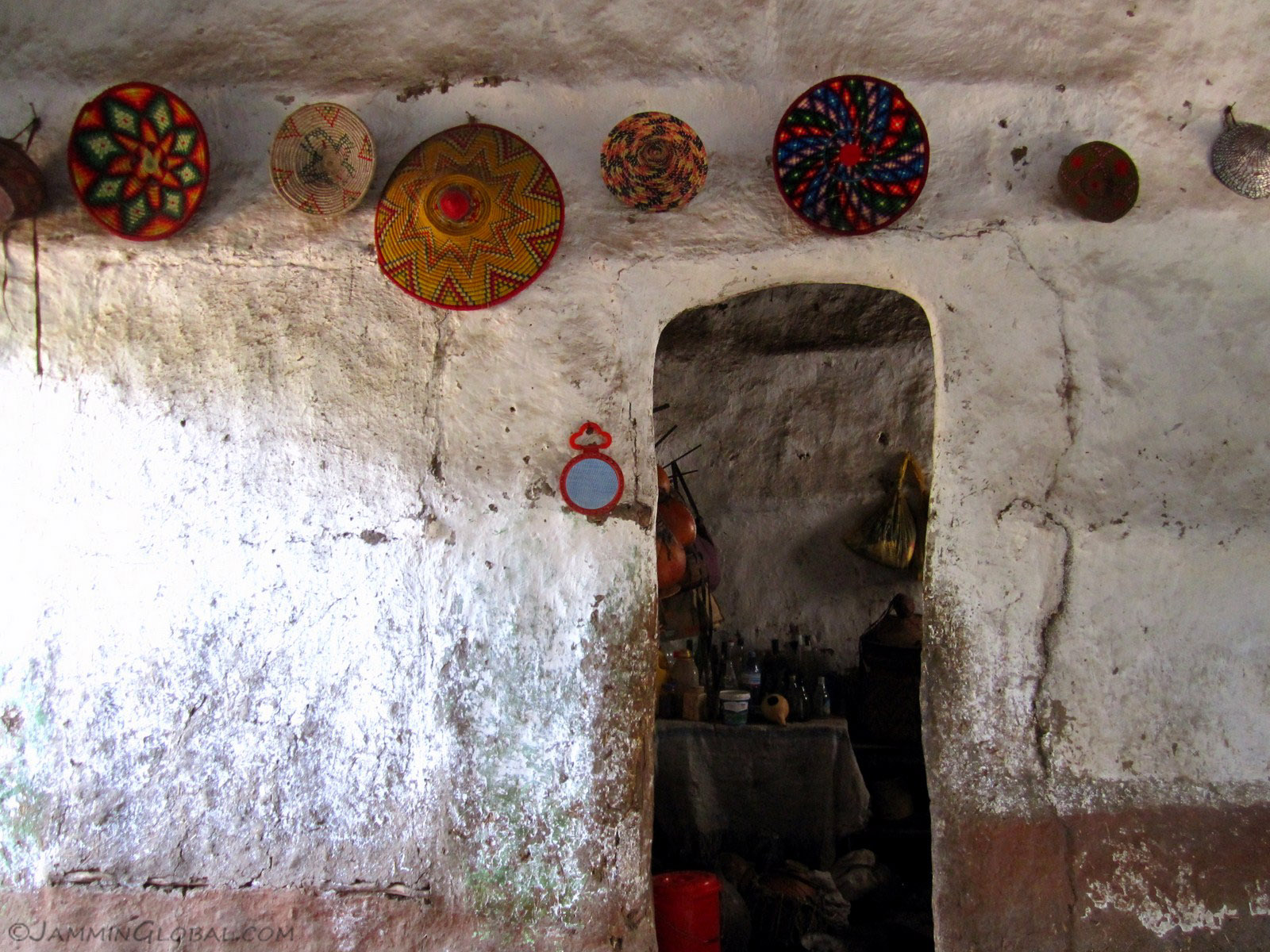
Inside a villager's home and capturing the colorful variations of injera covers.
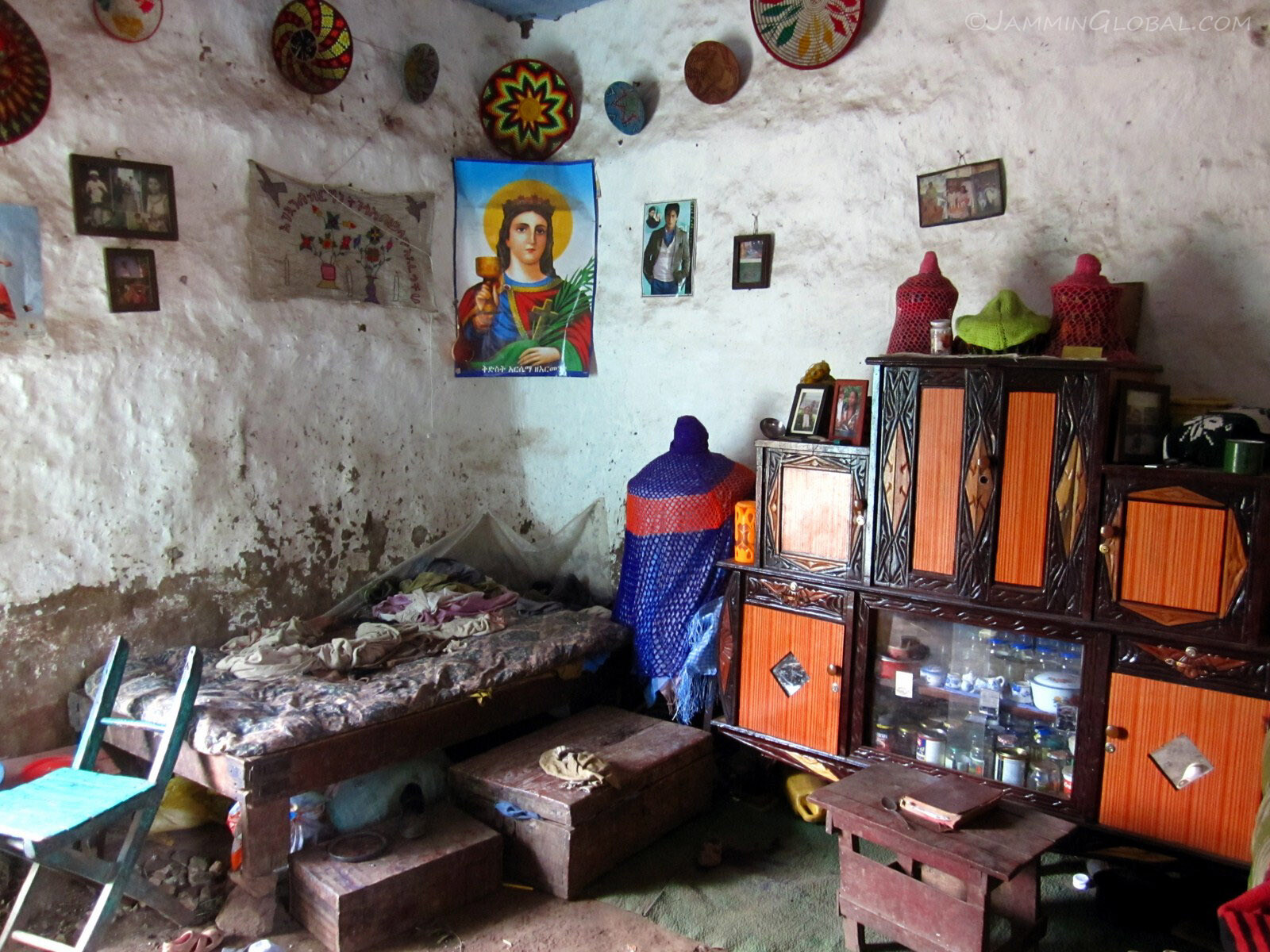
A bedroom in the village of Gorgora with a Christian saint placed prominently. Christianity was established as the state religion back in 4 AD and thus the evolution of Christianity in Ethiopia is different from the dominant sects around the world today.
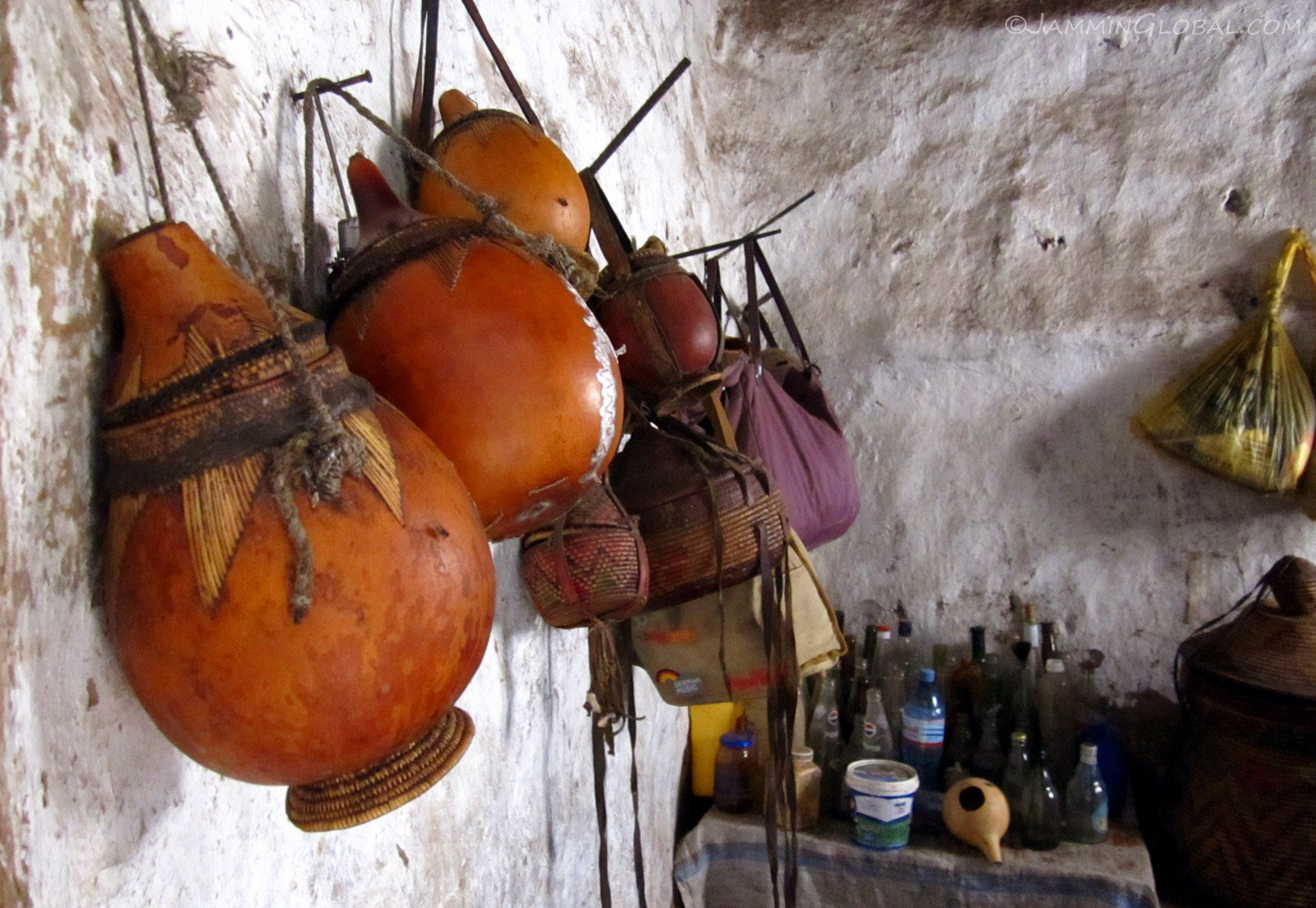
A collection of calabashes hanging on the wall, used as storage containers. They originated in southern Africa and they're considered to be one of the first cultivated plants by humans, mainly for their ability to store water.
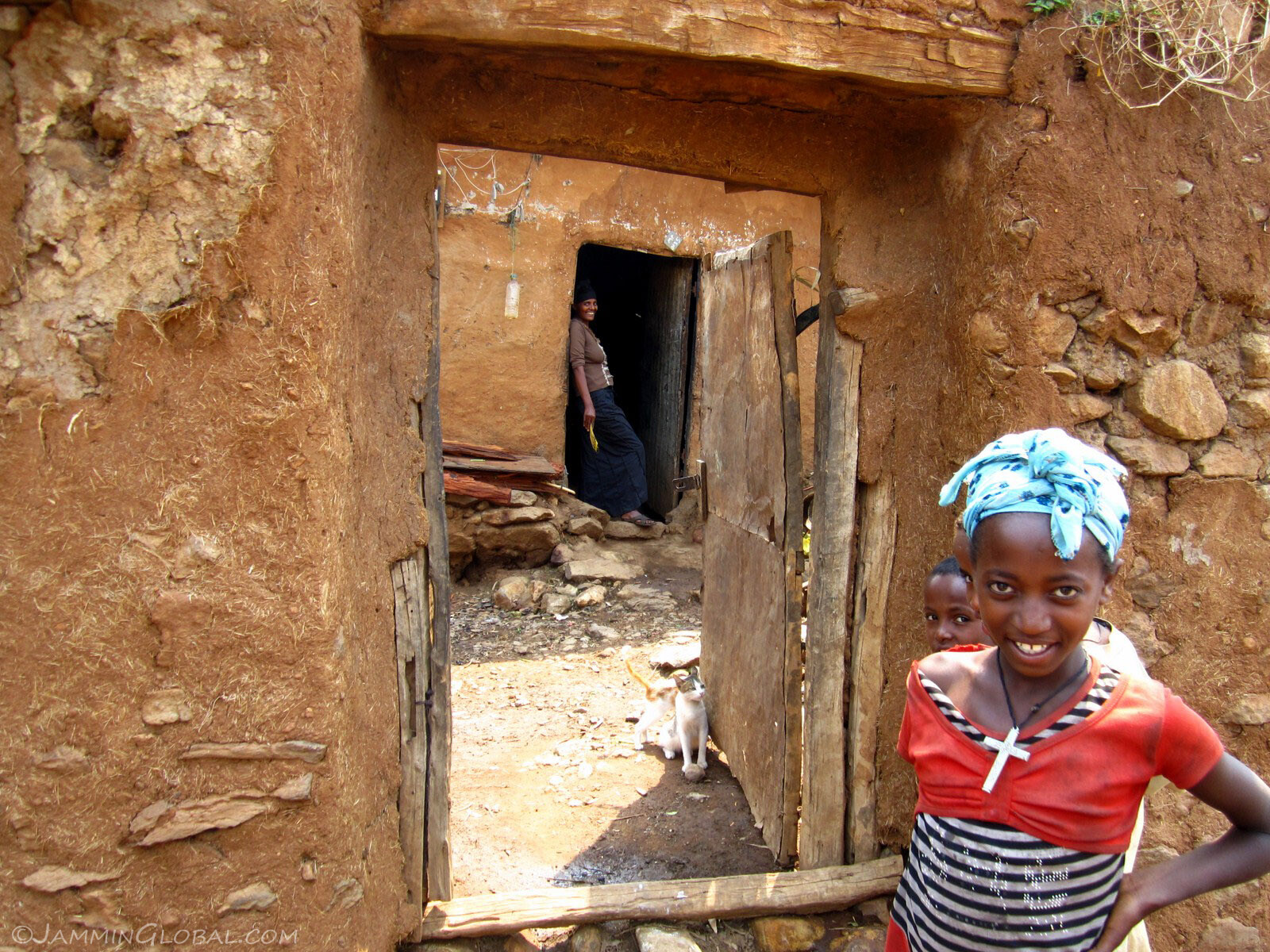
Two beautiful children outside their home with their mother looking on and the family cat by the door. Everyone was very friendly and also photogenic.
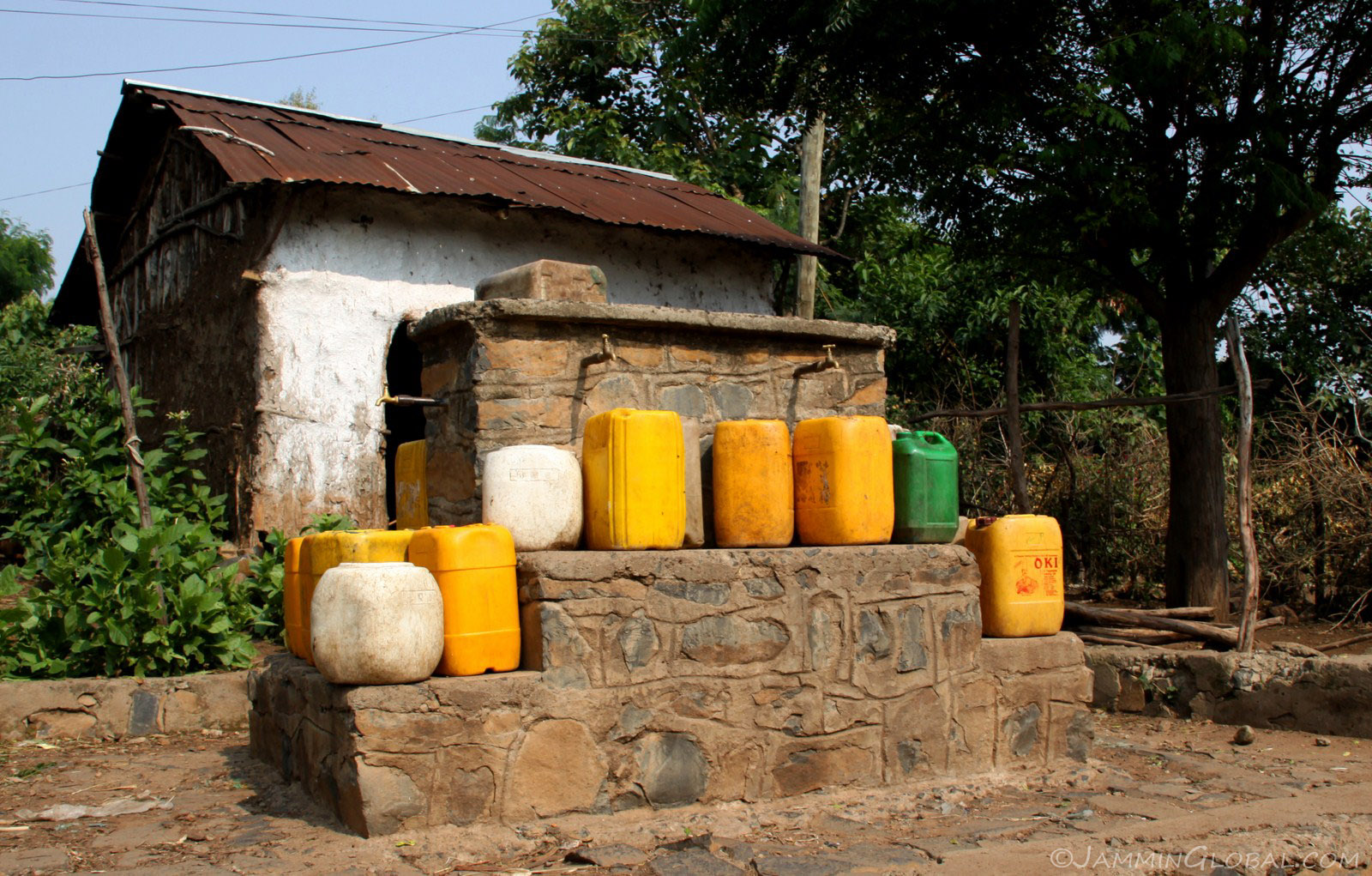
The main water source in Gorgora with 20 L jerry cans waiting for the water to turn on.

An outbreak of pandemonia.
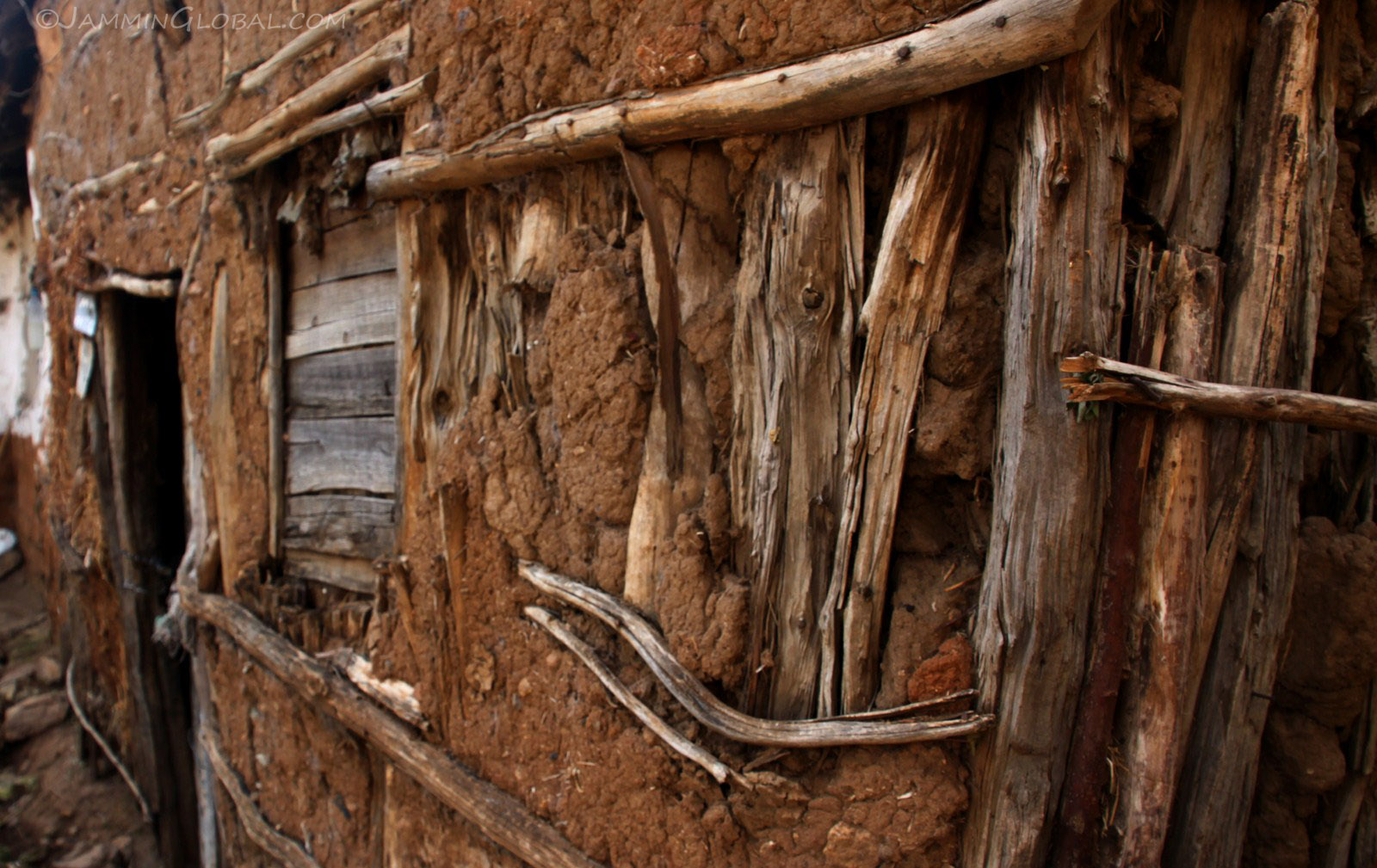
The texture of the walls in Gorgora. The majority of homes were constructed with thin tree limbs that were filled in with mud. With the bi-annual heavy rains, there was lots of reconstruction going on.
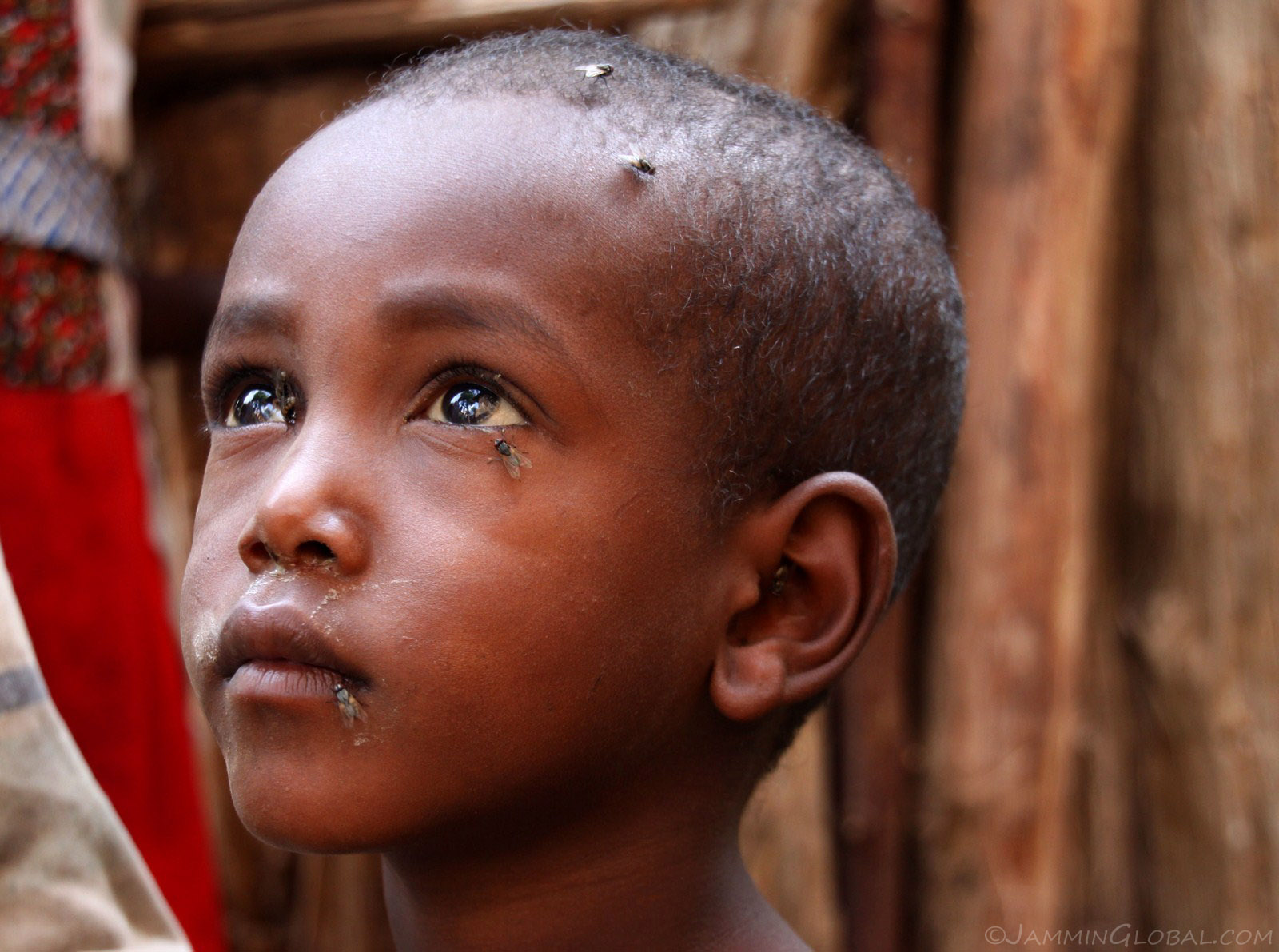
A beautiful Ethiopian boy caught in a moment of attention in the village of Gorgora. Besides being amazed by his tolerance to all the flies on him, I was drawn to the high symmetry of his facial structure, which triggers a good-looking face in our brains. I am thankful to his ancestors passing down those good genes, as they are also my ancestors, since humankind emerged from this part of Africa.
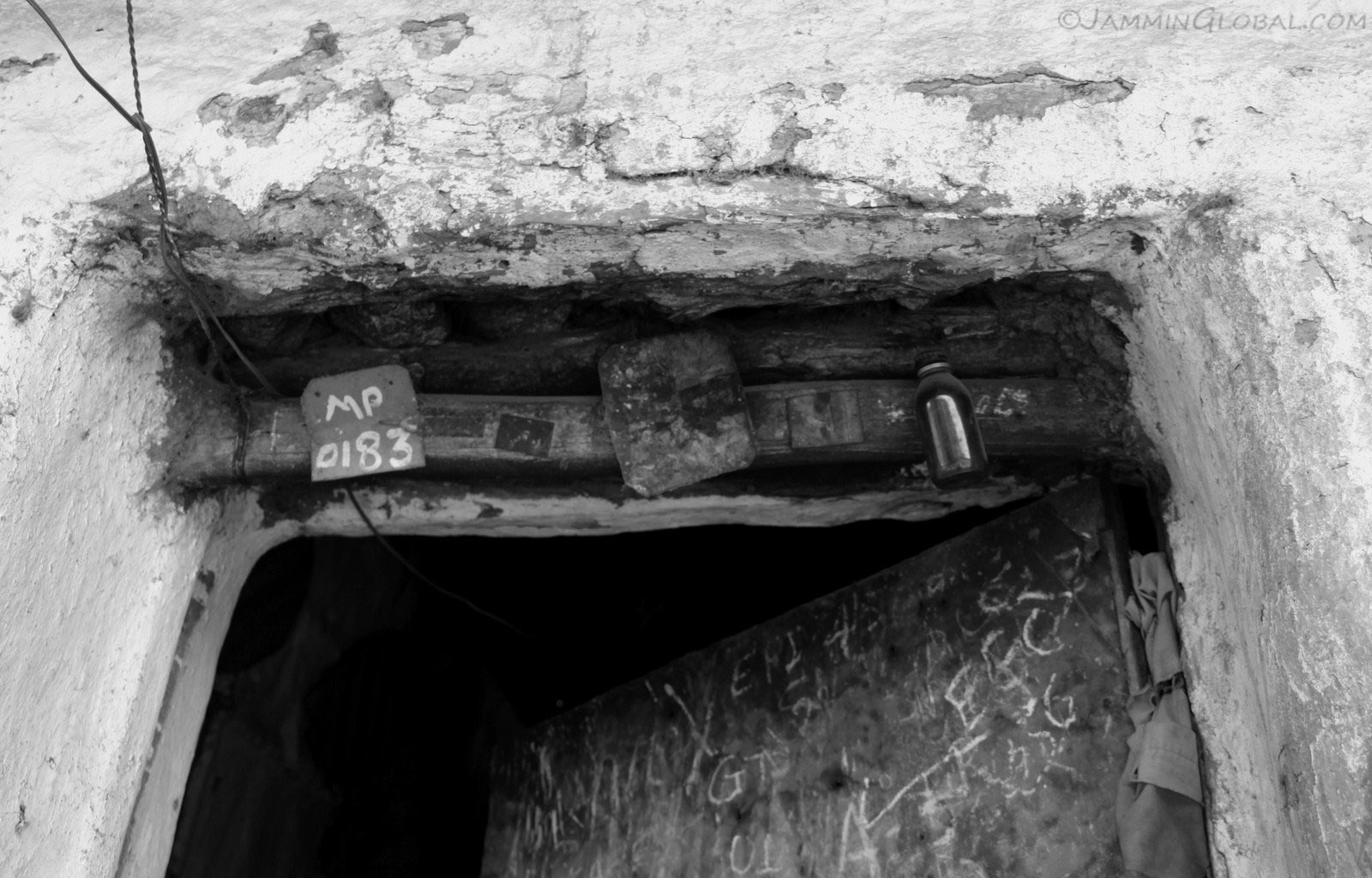
A doorway in Gorgora.
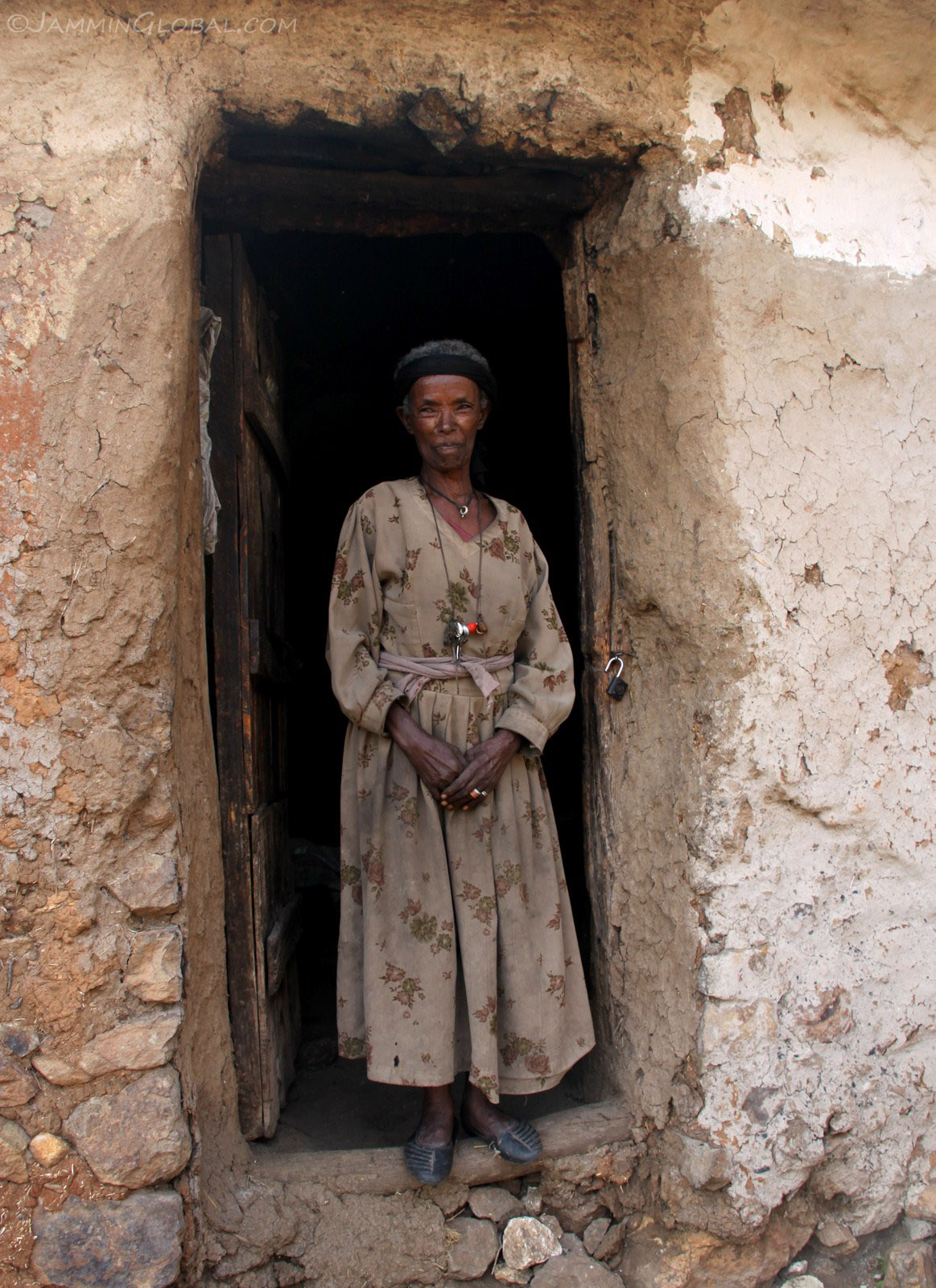
A villager posing in her doorway, almost blending in with all the browns in her life.
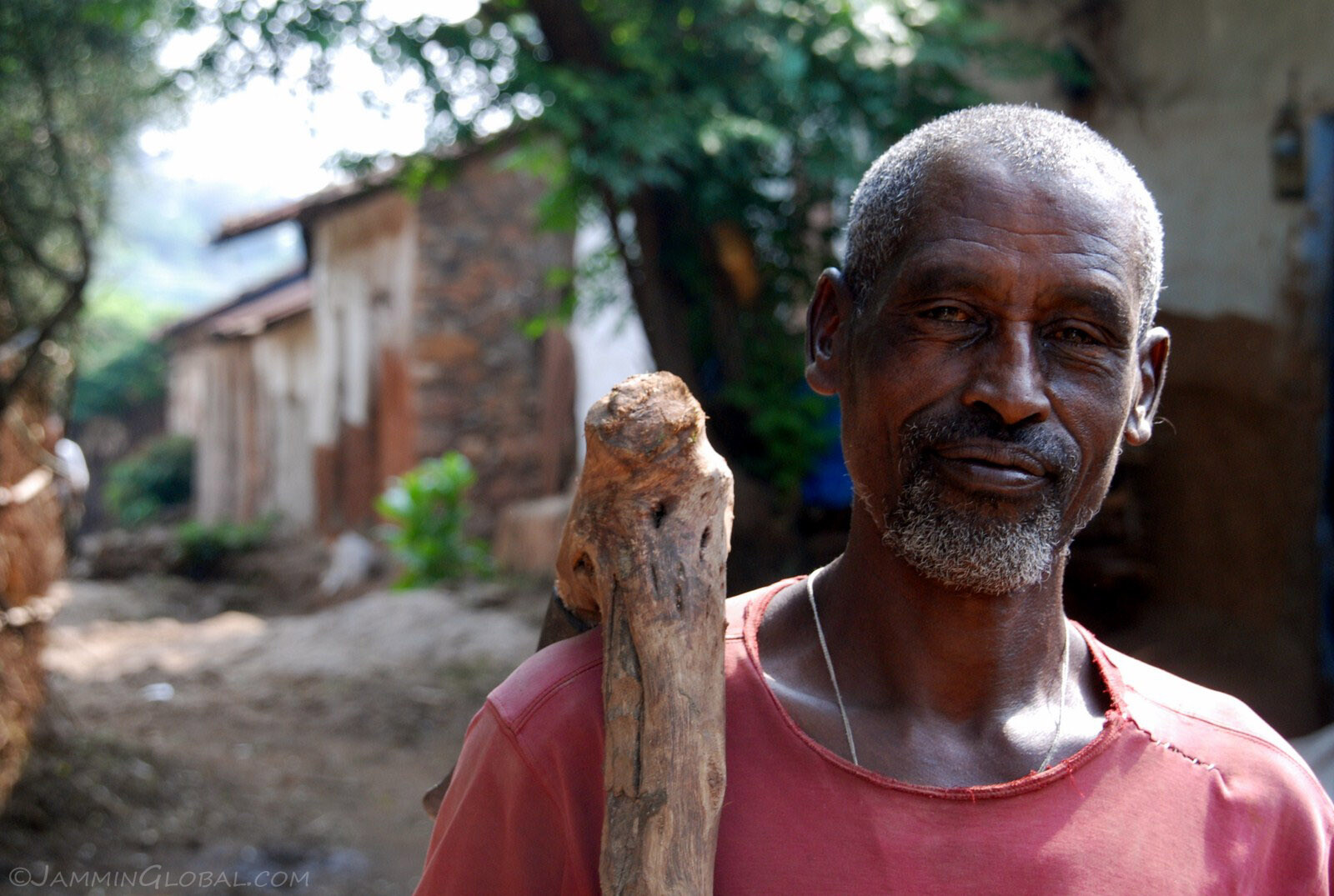
A portrait of a villager in Gorgora, who looks like he's got some stories to tell.
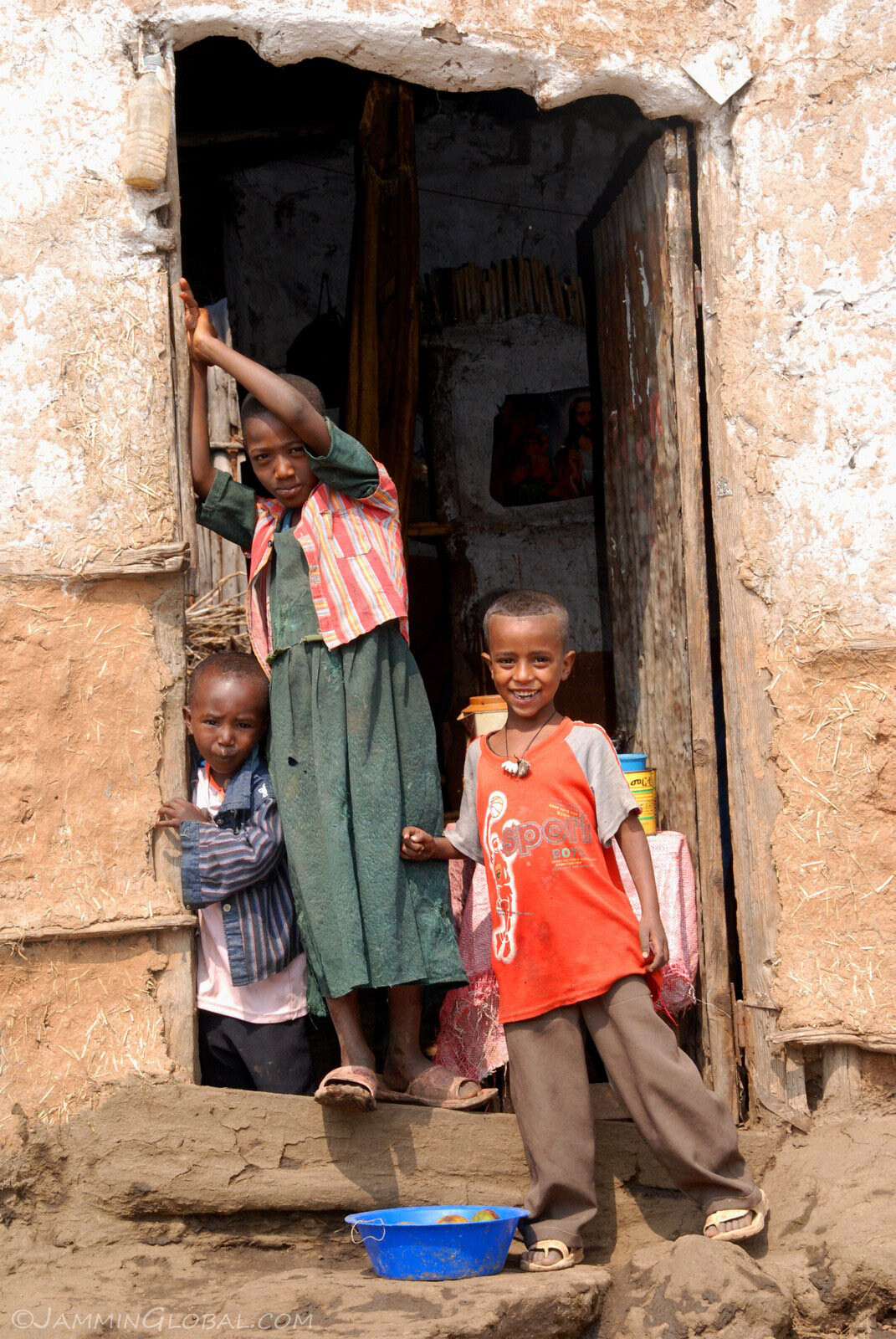
Happy children in front of their house.
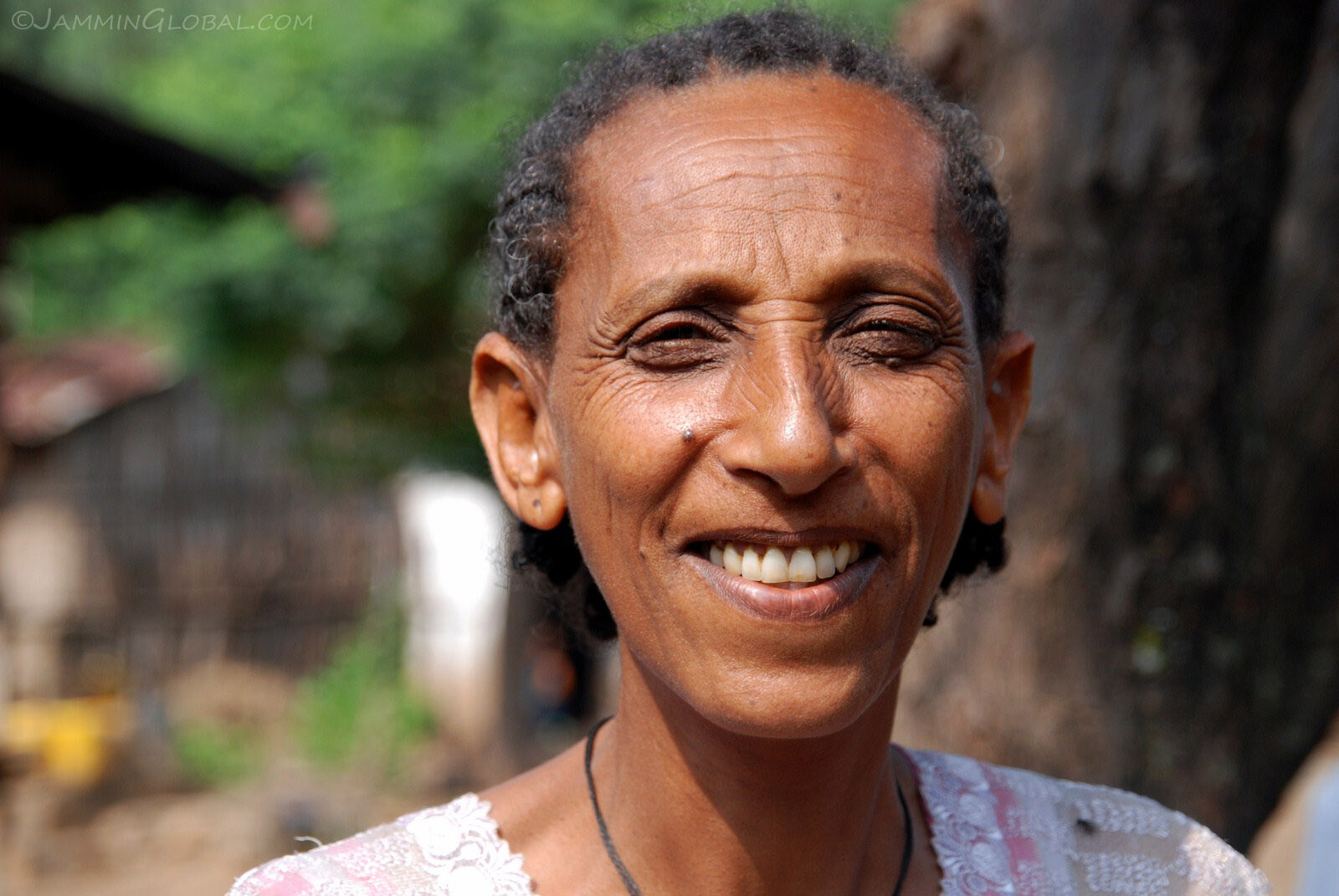
A smile from a villager in Gorgora.
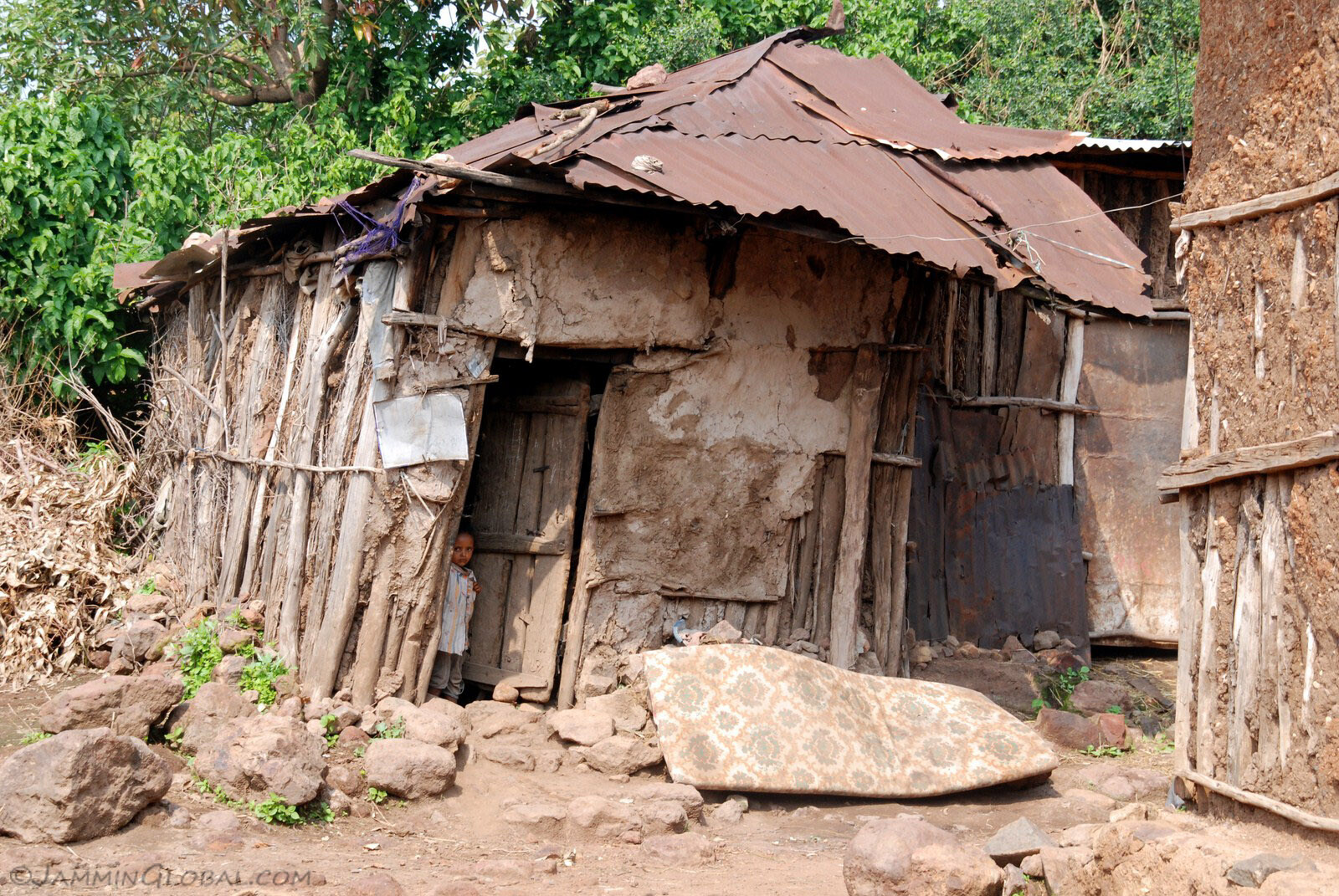
A leaning house that is slowly succumbing to the erosive power of rain on these mud and timber structures.
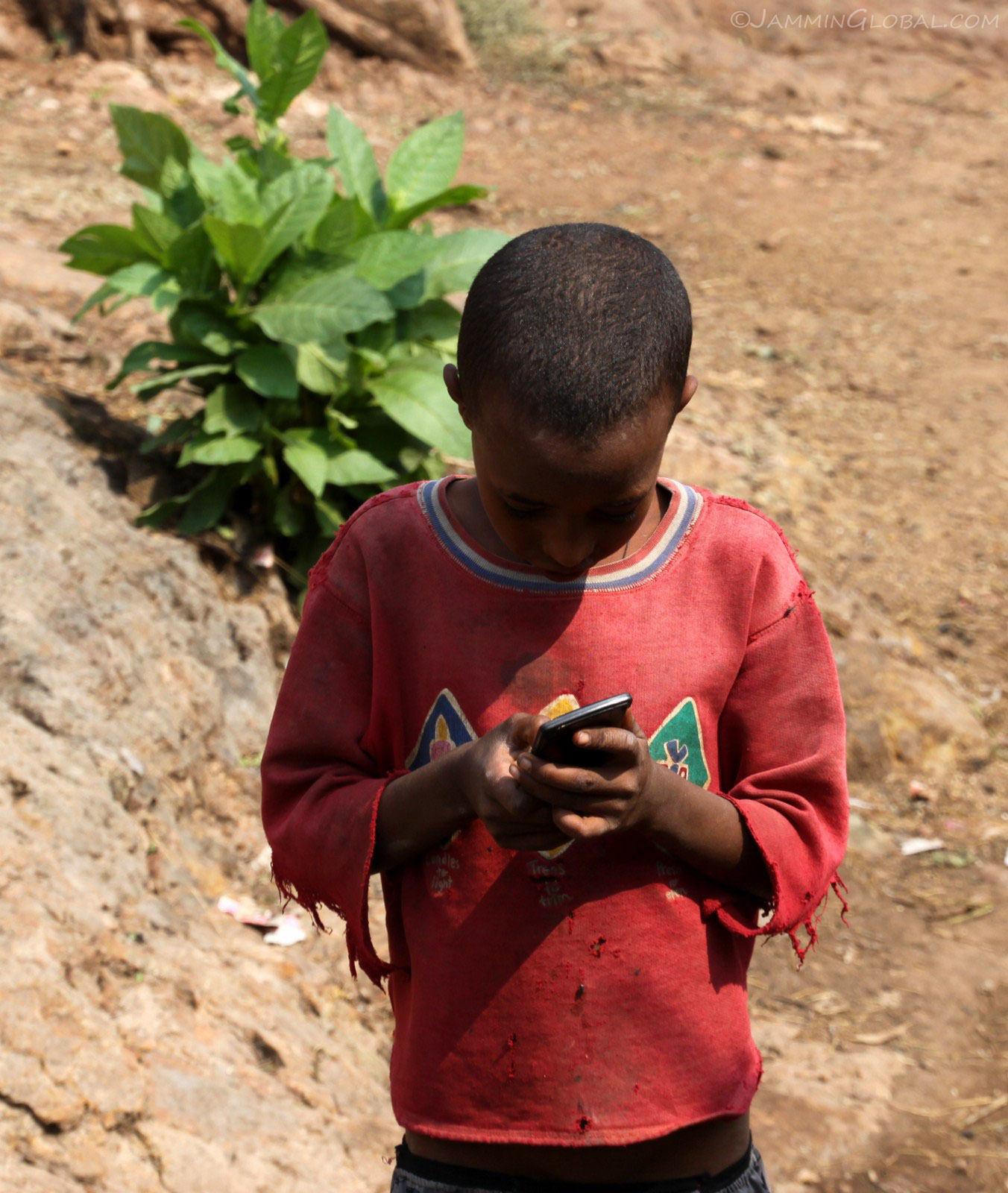
A child absorbed with the razzle of technology.
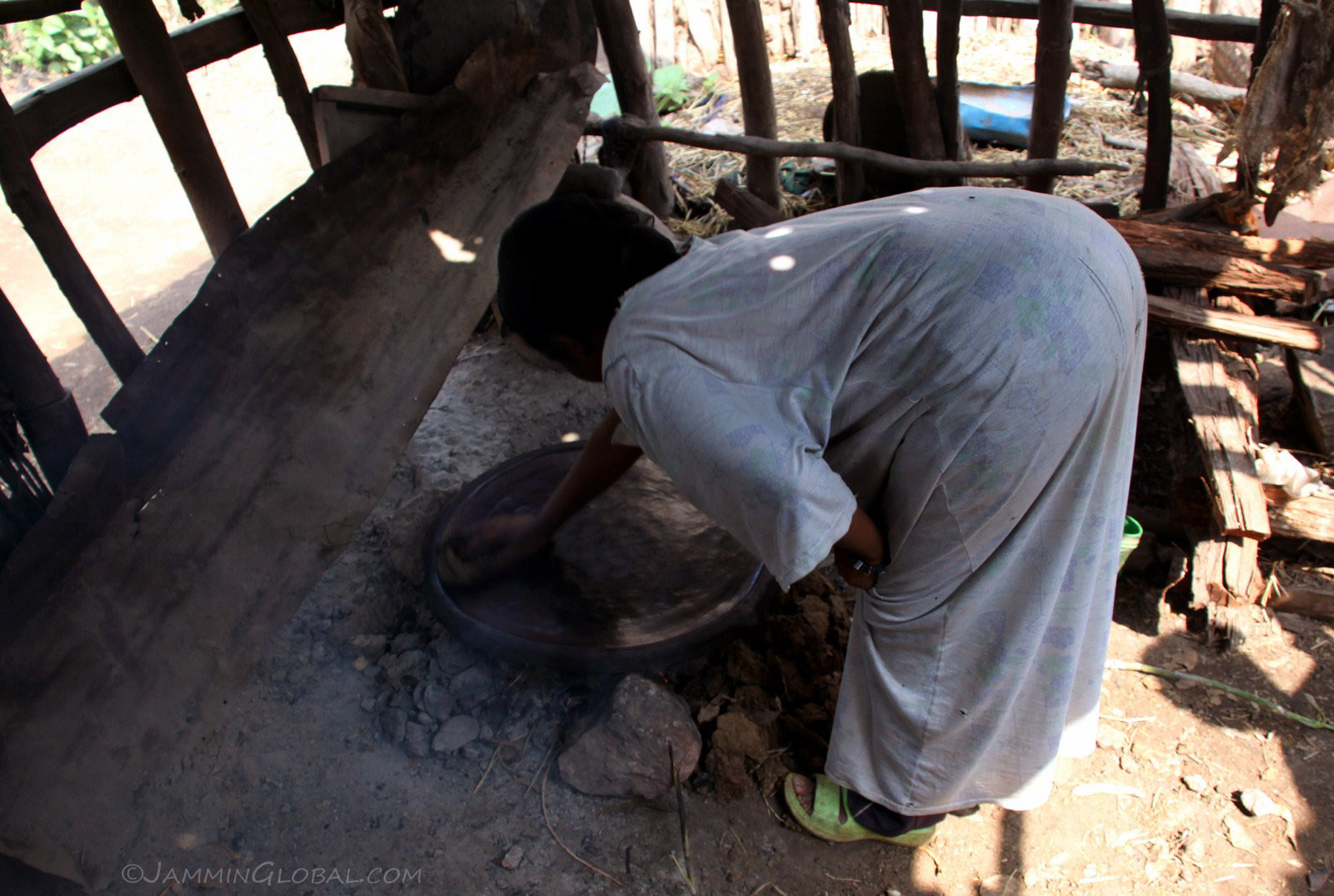
This woman was preparing some injera and let me into her open-air kitchen. The thick pan is cleaned, lightly oiled...
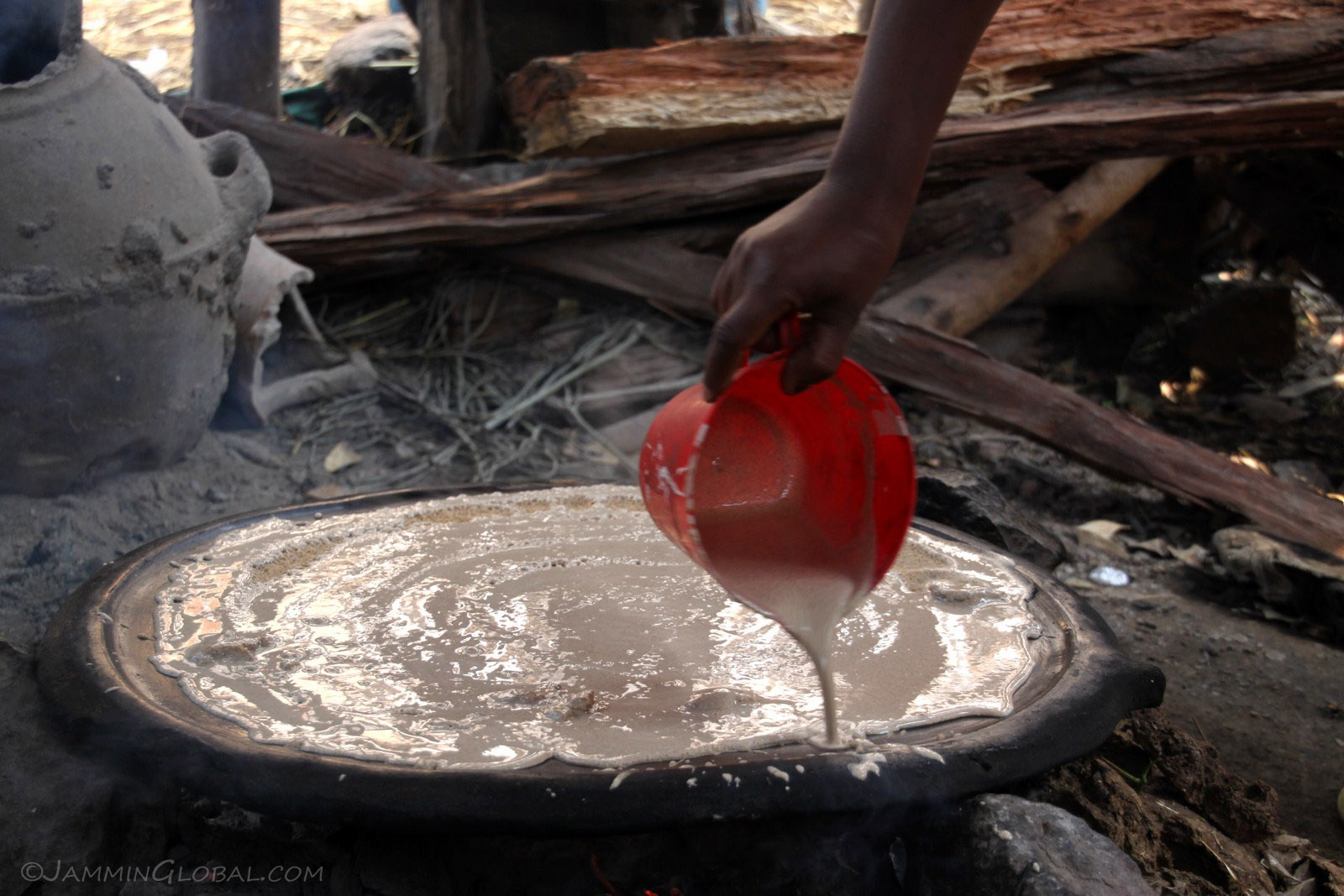
...and then the injera dough is spread in concentric circles, from the center to the outside, filling the whole pan...
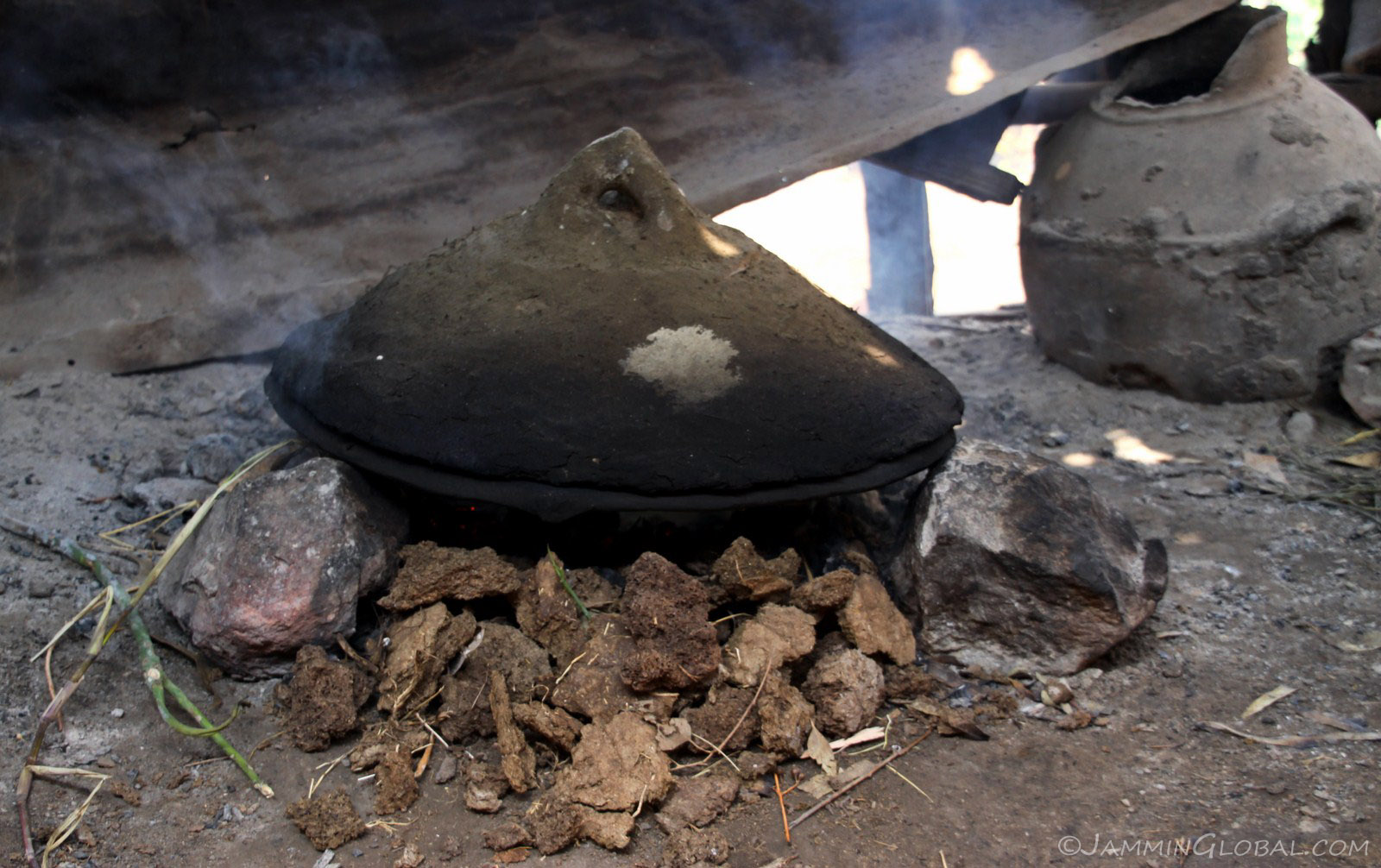
...which is then covered and allowed to bake until the dough is cooked. This cover has been sealed with cow dung and its long use is evident by the black charring.
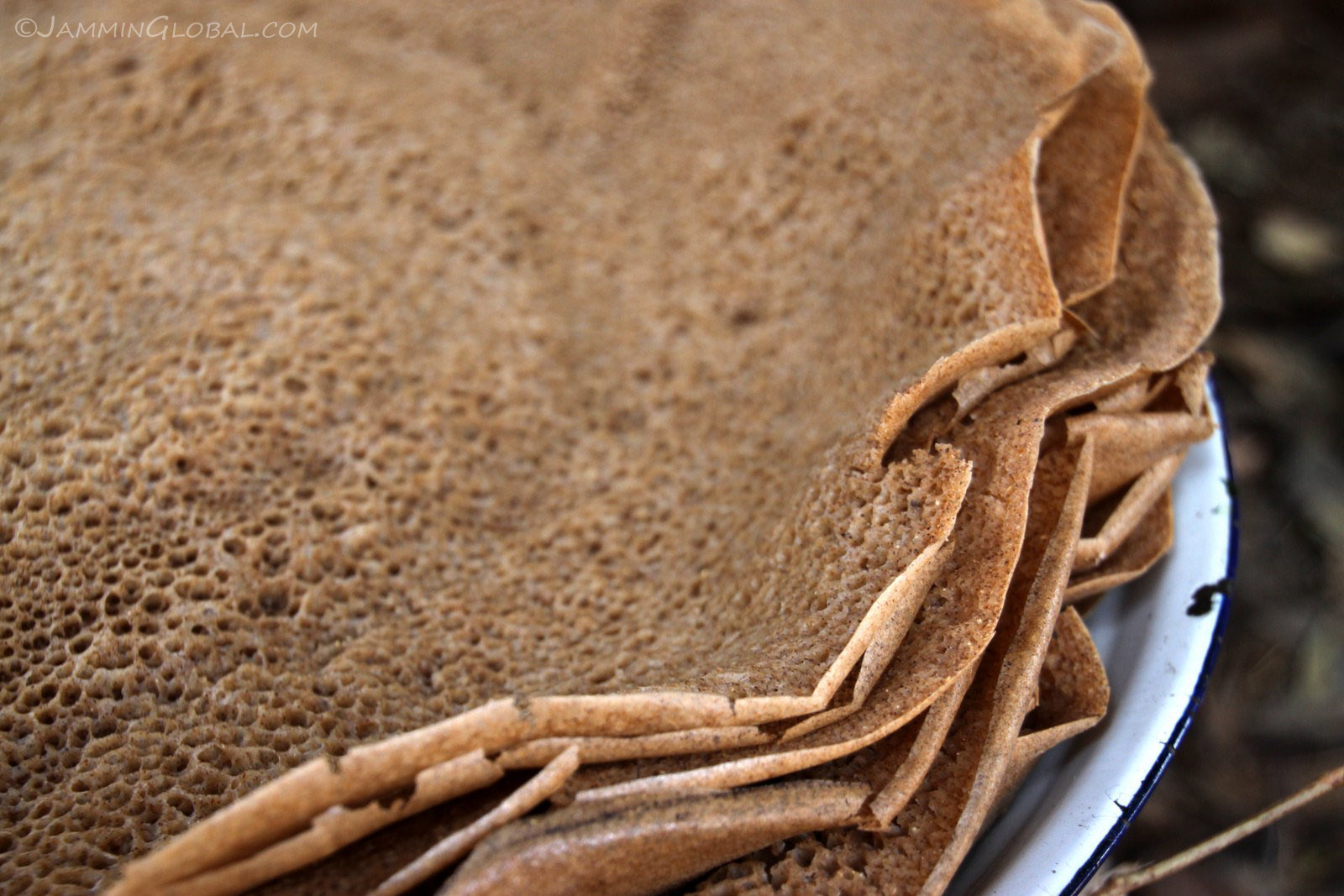
Freshly-made injera in Gorgora. There's good injera and poorly-made injera and this looks like the good kind.
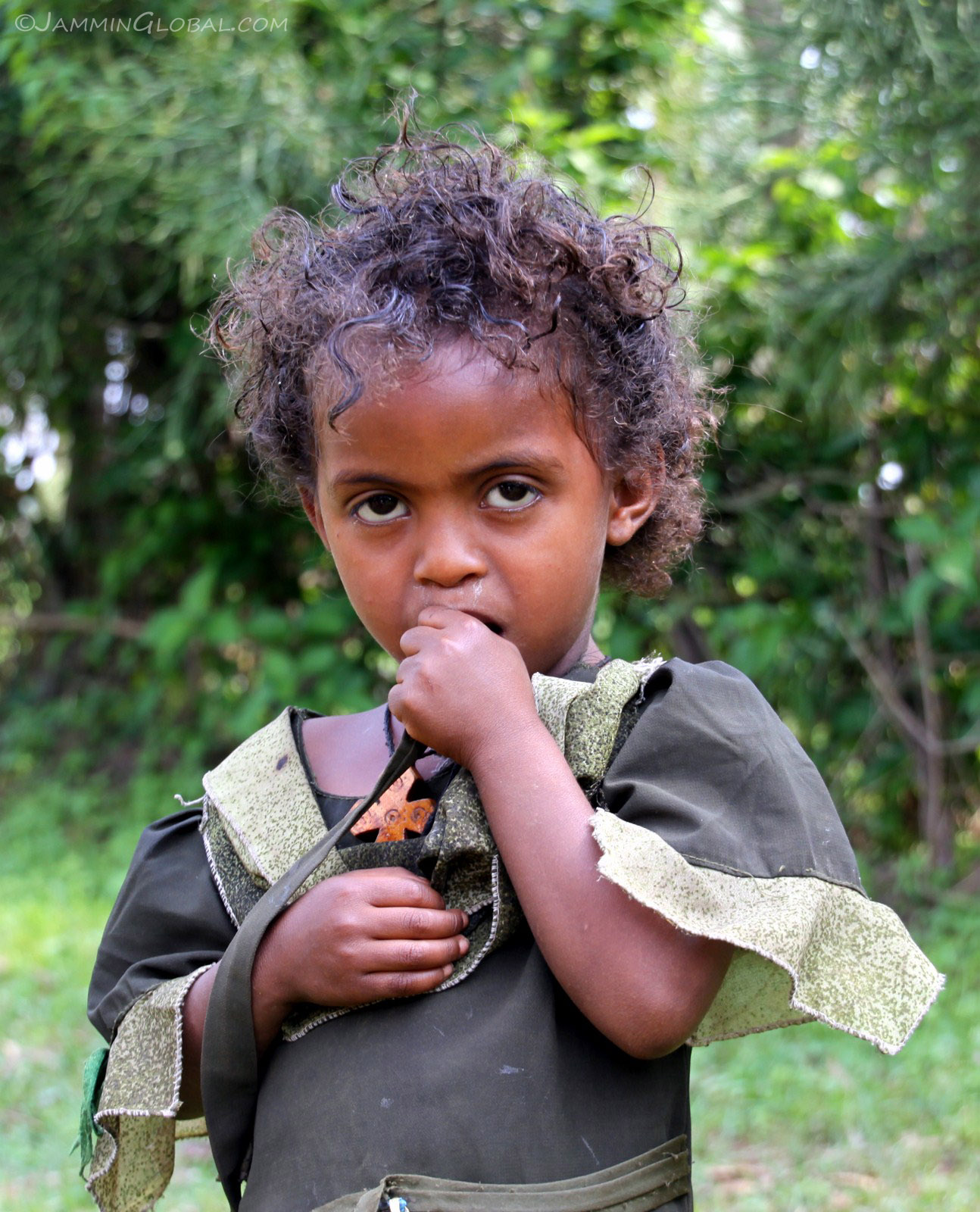
A complex stare from this girl in Gorgora.

Sun-drying fish caught from Lake Tana.
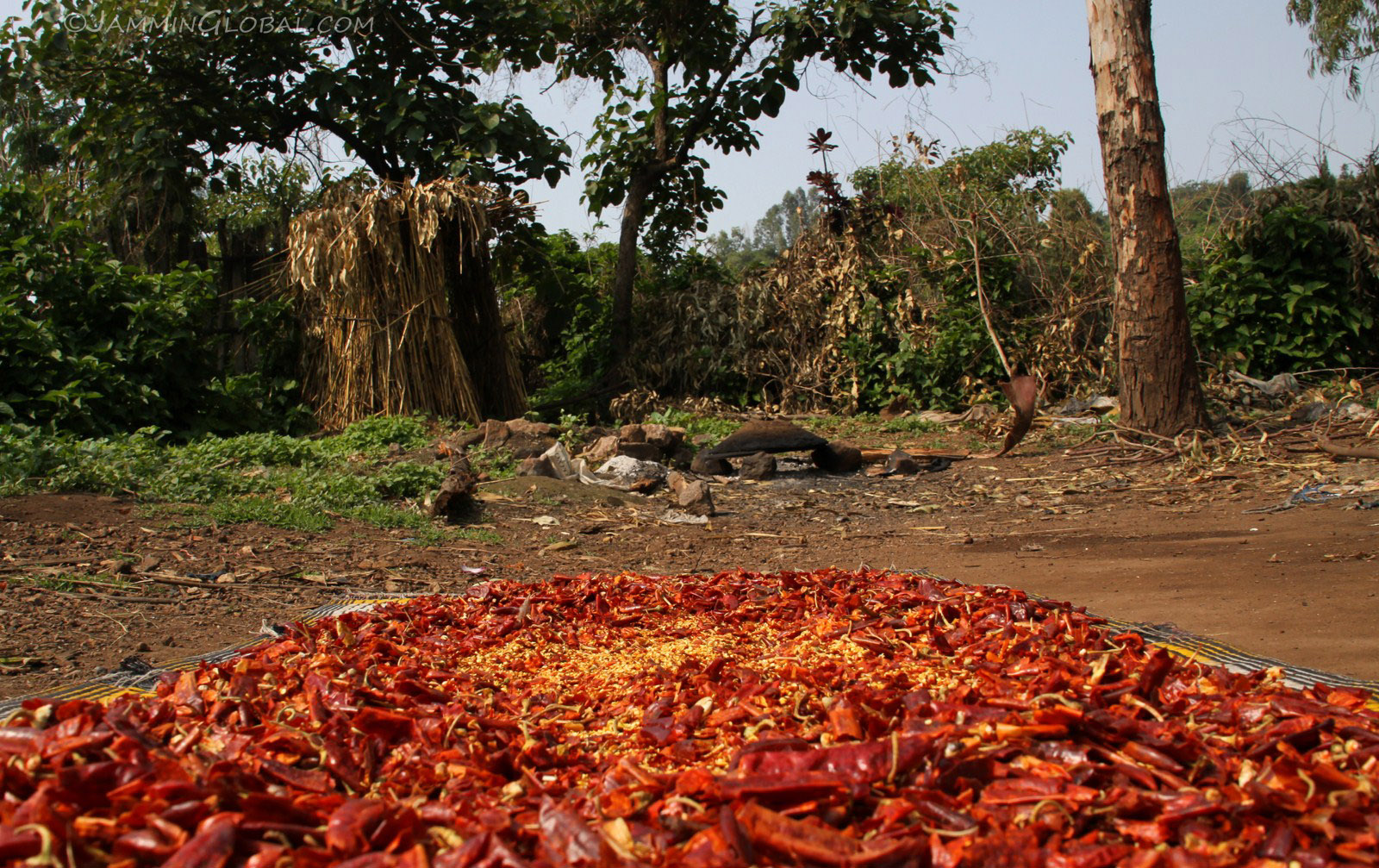
Red chilies drying in the sun. They are the main ingredient in the berbere spice mix, which also includes dried garlic, ginger, basil, fenugreek and a few other indigenous ingredients that give it its unique flavor.
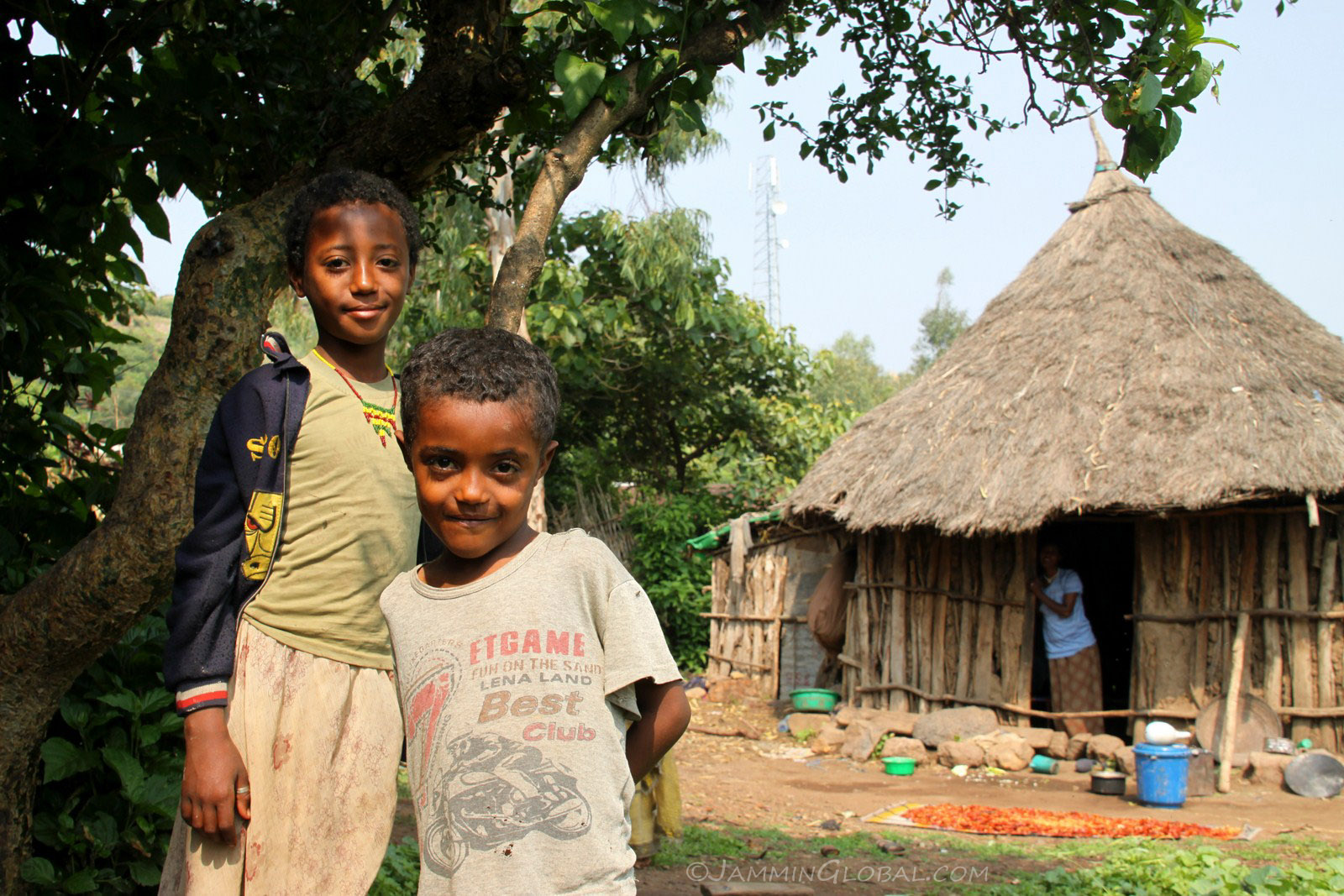
The natural beauty of Ethiopians showing through in these children, as their mother watches from their doorway.
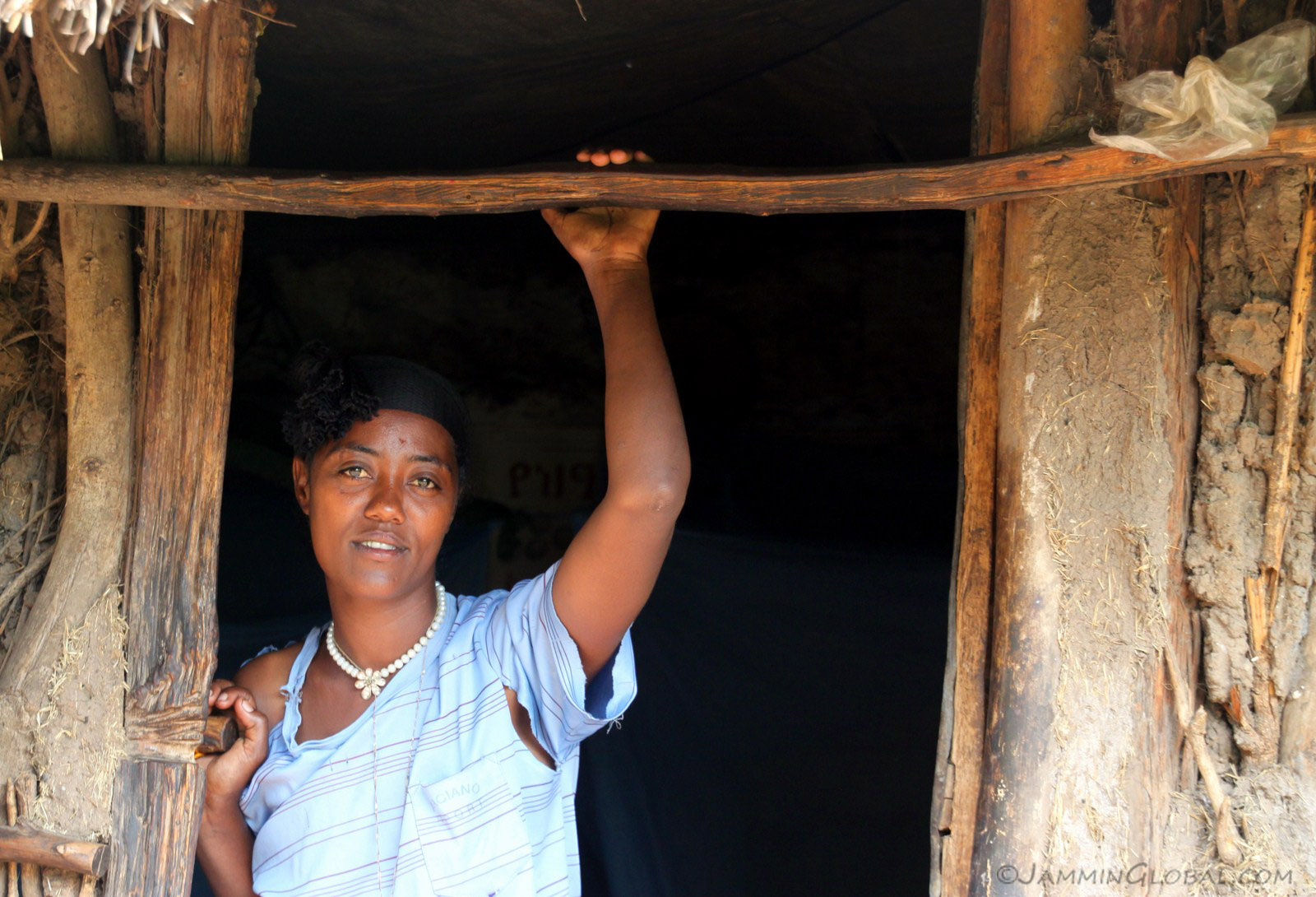
A portrait of an Ethiopian mother and homemaker in the village of Gorgora.
I enjoyed my first week at Tim and Kim's and relished the ability to stay put in a place for more than a few days. It allowed me to get to know a community and become a part of it during my short time in Gorgora. The villagers were all very welcoming and beautiful and their cuisine and culture reminded me of village life in my parents' villages outside Madras, India.
Next: Ethiopia, Part 2: Life in Gorgora and Downtime at TimKim Village